External links now open in a new browser tab - turn this off in your UCP - Read more here.
Turbo ETA build
Re: Turbo ETA build
Head looks similar, irregularly shaped angular dents in the quench area. Not bad enough to worry about, just ugly. I'll probably use those pistons again in a fresh block.
I do wonder what could have caused it. All six have that damage. Could have been porcelain chunks from a bad set of platinum plugs. That would easily score the cylinder wall too.
I do wonder what could have caused it. All six have that damage. Could have been porcelain chunks from a bad set of platinum plugs. That would easily score the cylinder wall too.
Re: Turbo ETA build
Much progress has been made with this new motor. The biggest change was made upon revisiting the trigger angle offset in megasquirt. The trigger angle offset was set to 97 degrees from the vendor I purchased the PNP ECU from. I had been running that all along and it's been working well. I don't know if there is something that changed with this motor, it's still a super ETA bottom end just a different one. Changing the trigger angle offset to 84 degrees adds 13 degrees of timing across the board, and this engine responded very well to that. I also had to pull a bunch of timing out under boost though, can't just add 13 degrees up there and expect it to be fine. I am more confused than ever about the correct setting here, I may grab a timing light to verify where it thinks TDC is right now. In any case, it's running great. Idle vacuum dips down to 34 kpa when the engine is fully warmed up which is higher than either of the other camshaft/engine combos I've run but I think it's an acceptable value.
The amount of torque this B25 cam produces with the small turbo is remarkable. It pulls well from very low revs. It hits hard at 4k, whereas the catcams turbo cam comes on a little later and produces a more manageable impulse. With the B25, the midrange bump is very pronounced and tends to break traction more easily. I broke loose today while rolling into WOT in third gear, in full disclosure it was raining but still. That's some pretty good hit. I still don't know if I like the turbo cam better. They're both good.
One thing I did find while looking through datalogs was some spurious activation of acceleration enrichment during roll on's. It was triggering the TPS based AE three times before I made it to WOT while slowly putting my foot into it. The fix was to extend the taper time for the original accel event to prevent subsequent activations. EAE works on a much longer time scale than what I used to use for TPS based AE so I figured why not extend the TPS AE to work more like the wall wetting algorithm. So far so good. Throttle transitions are tricky and this is the best it's been in a long time.
If anybody needs a MS tune for a 2.7i this one is pretty good. Could always be better but this is a great start.
The amount of torque this B25 cam produces with the small turbo is remarkable. It pulls well from very low revs. It hits hard at 4k, whereas the catcams turbo cam comes on a little later and produces a more manageable impulse. With the B25, the midrange bump is very pronounced and tends to break traction more easily. I broke loose today while rolling into WOT in third gear, in full disclosure it was raining but still. That's some pretty good hit. I still don't know if I like the turbo cam better. They're both good.
One thing I did find while looking through datalogs was some spurious activation of acceleration enrichment during roll on's. It was triggering the TPS based AE three times before I made it to WOT while slowly putting my foot into it. The fix was to extend the taper time for the original accel event to prevent subsequent activations. EAE works on a much longer time scale than what I used to use for TPS based AE so I figured why not extend the TPS AE to work more like the wall wetting algorithm. So far so good. Throttle transitions are tricky and this is the best it's been in a long time.
If anybody needs a MS tune for a 2.7i this one is pretty good. Could always be better but this is a great start.
Re: Turbo ETA build
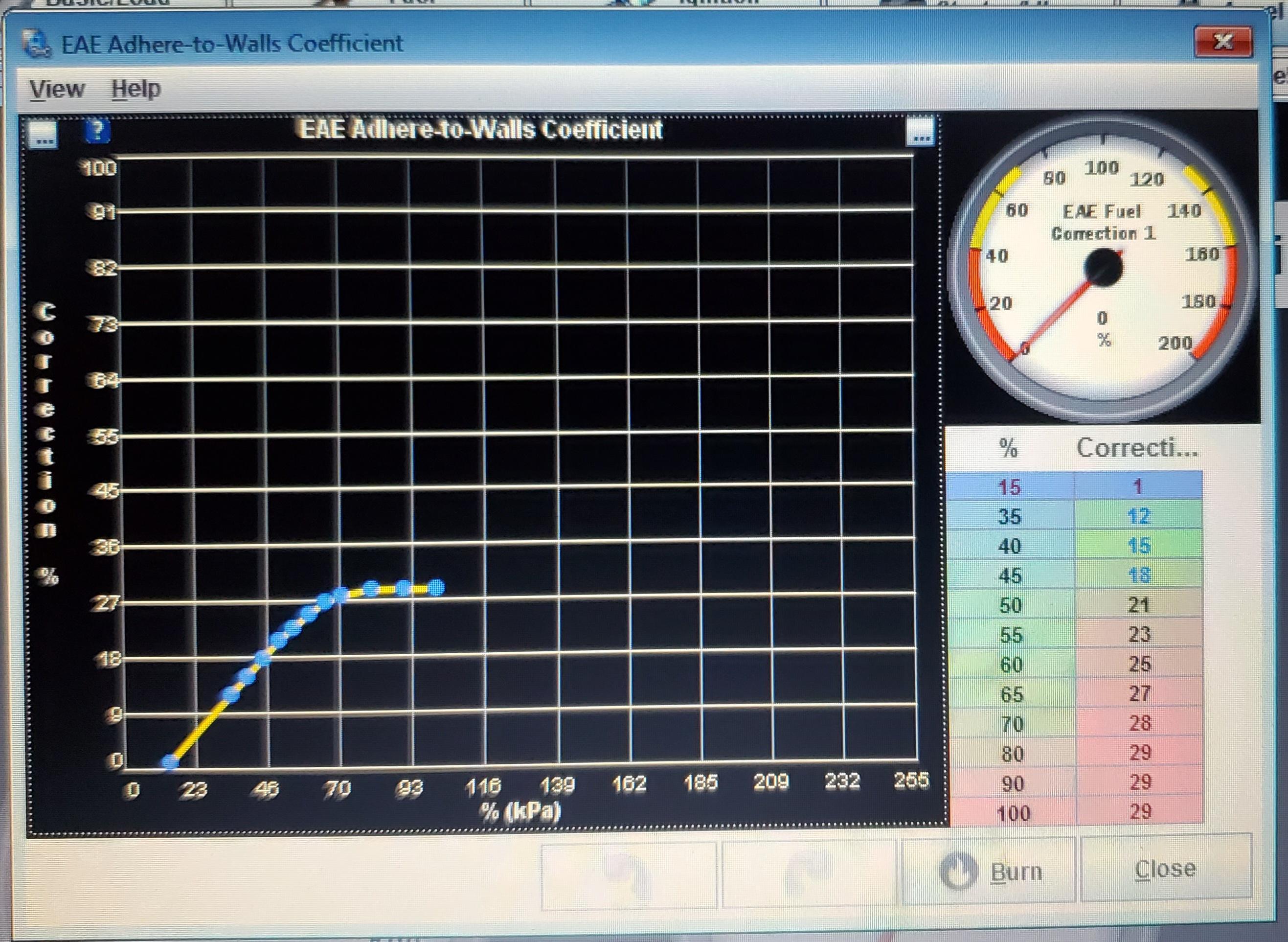
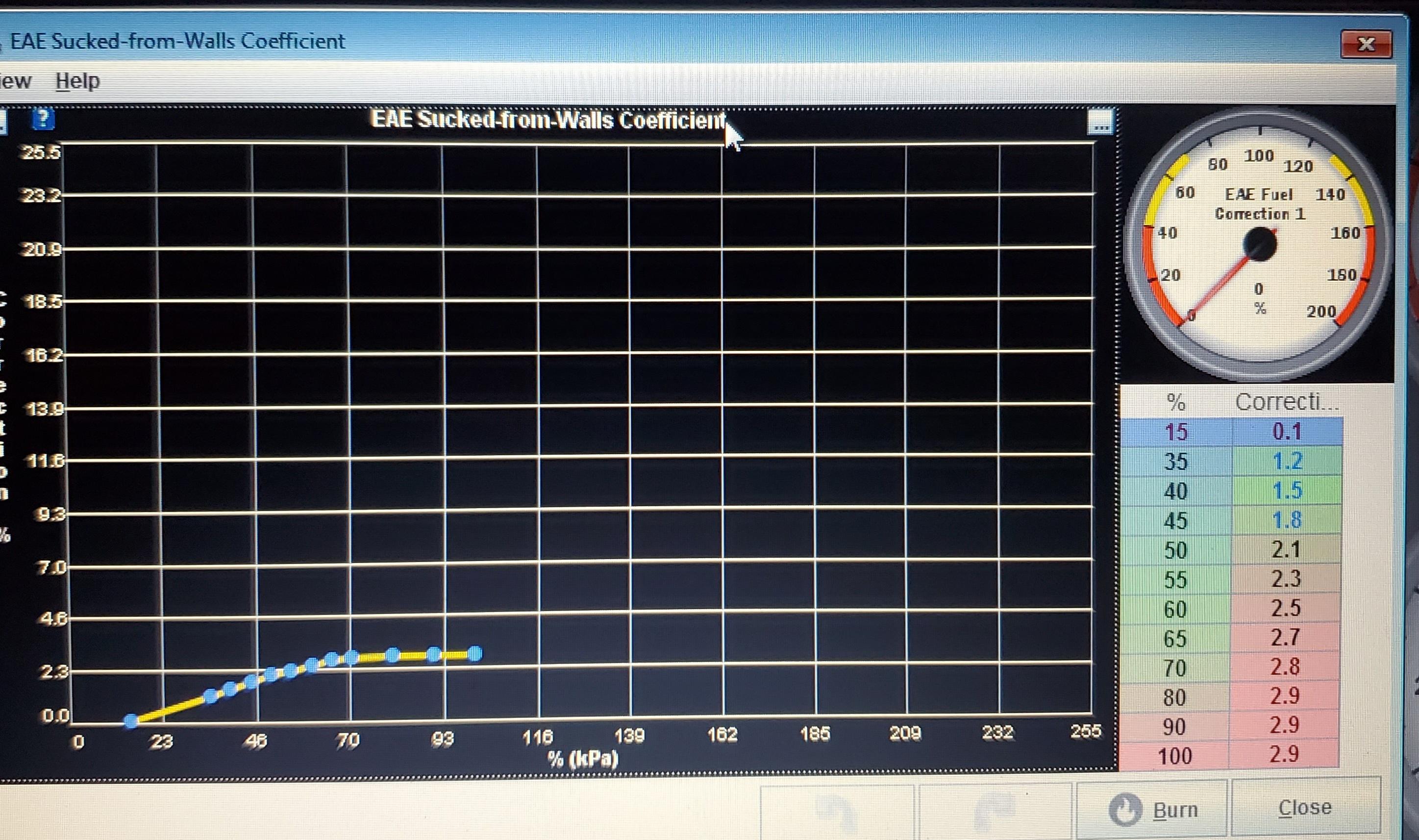
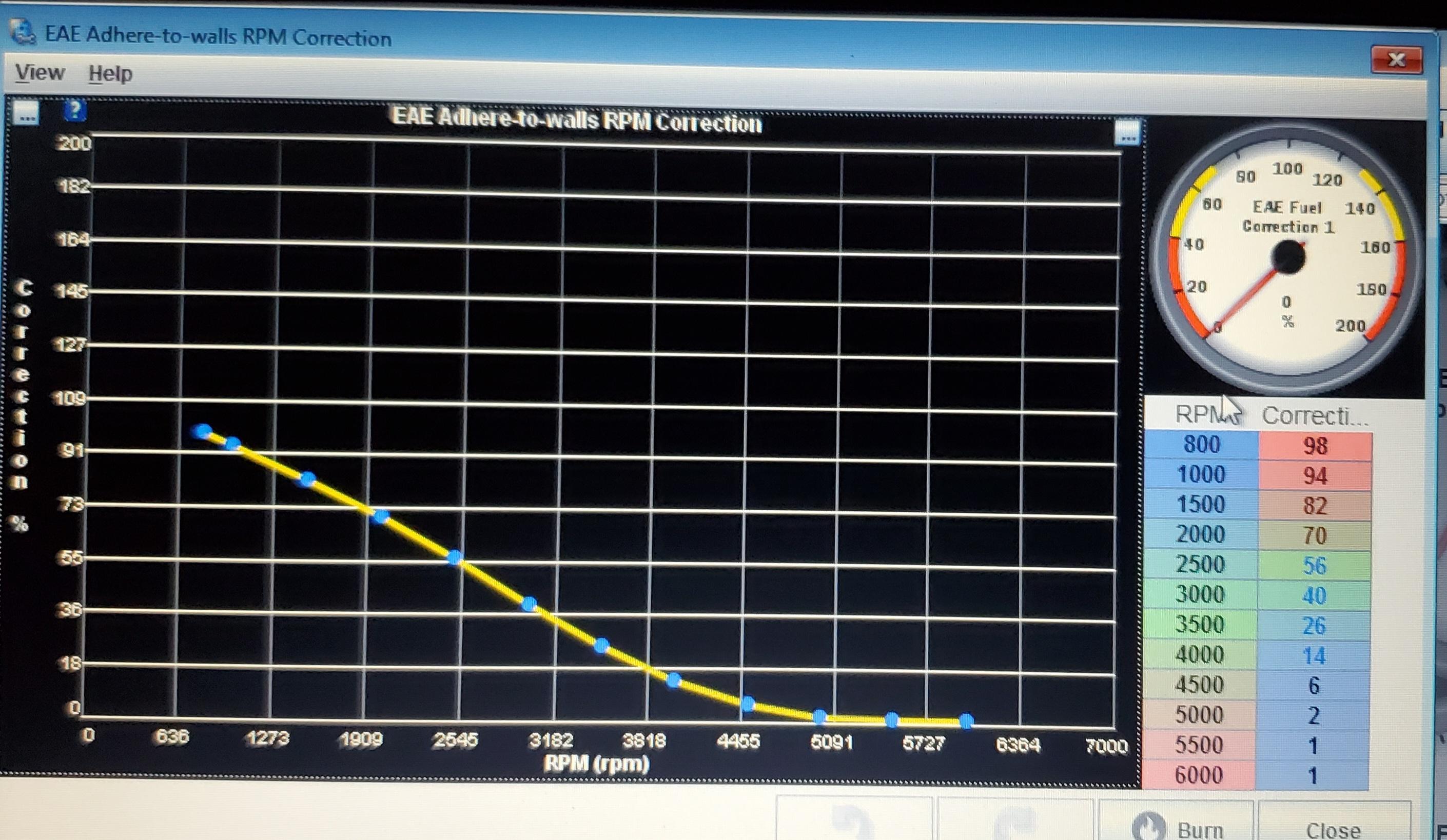
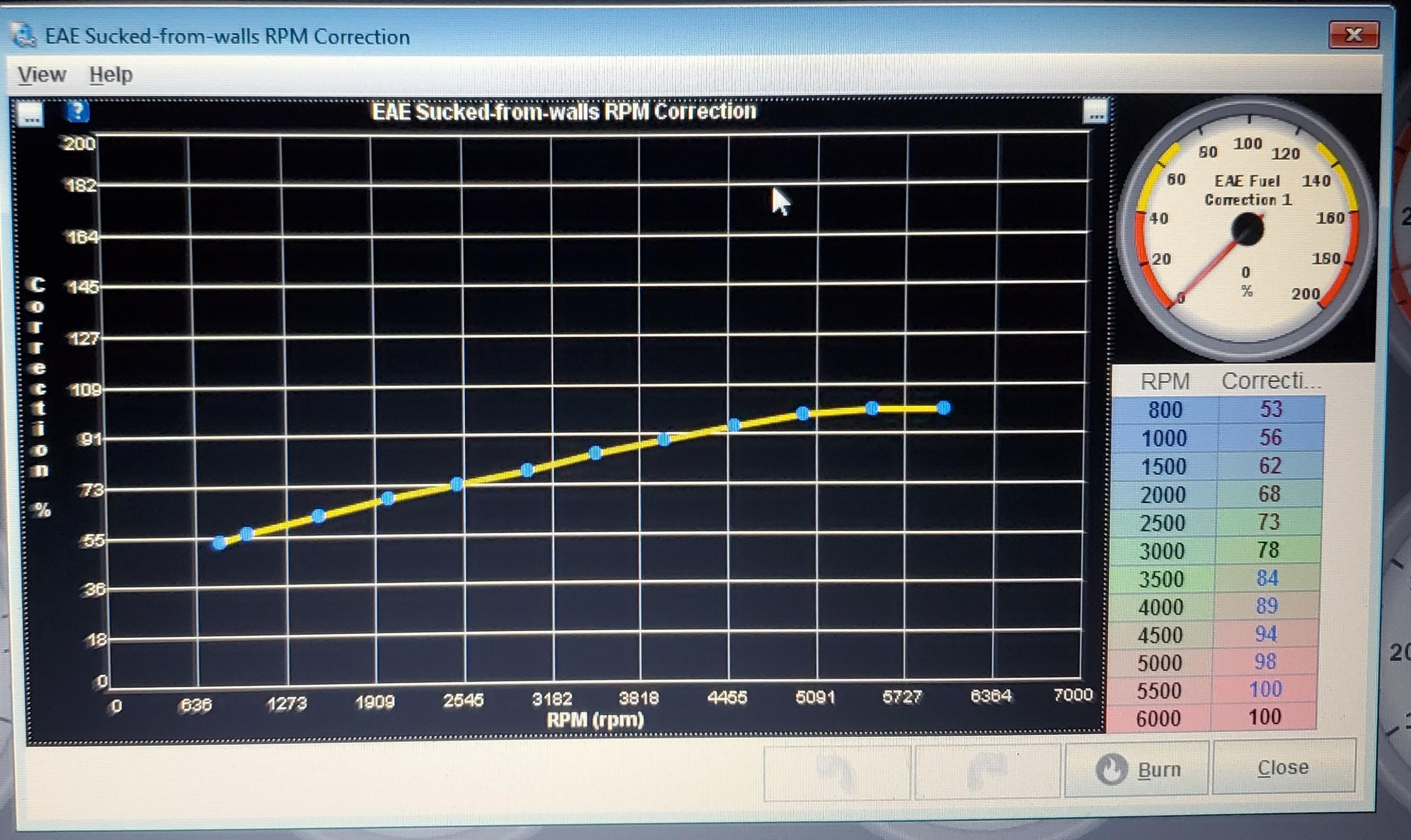
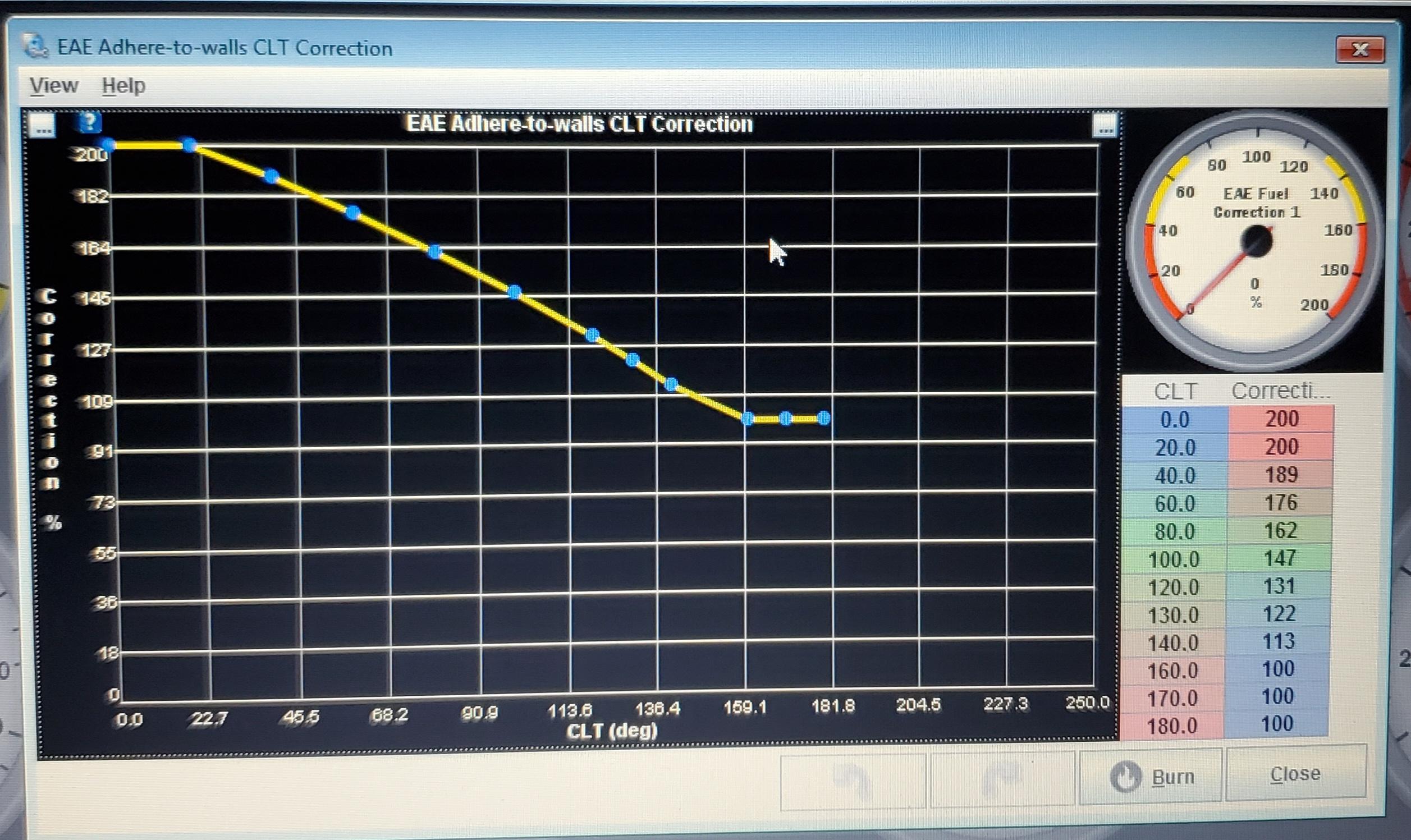
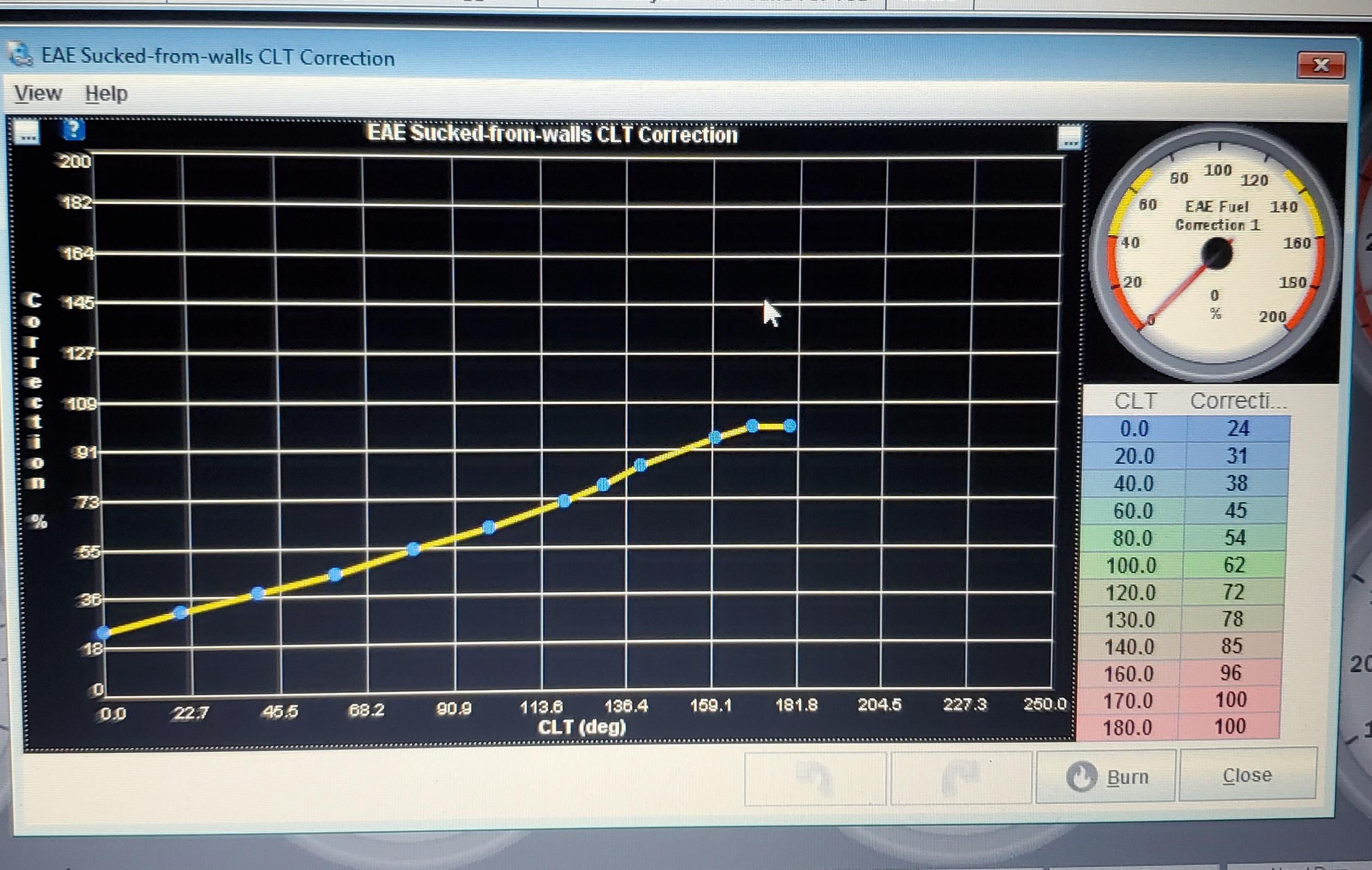
If anybody out there is fighting with EAE, these settings are working very well. I use a little bit of TPS based AE to help the rapid throttle movements but EAE does the heavy lifting with drivability. It saves gas too, pulling upwards of 30 percent out when you step off the throttle suddenly. When you lift off for a shift under boost, especially at low revs. Without EAE your AFR will go super rich. Cold drivability is much better too, it delivers enrichment for a much longer duration and in a smoother manner than traditional AE
Re: Turbo ETA build
Thanks for sharing, I will have to try similar settings! Can you share your associated tps enrichment and blend settings for reference?
Re: Turbo ETA build
Yeah I'll post em up next chance I get. These will only work properly for 30 lb injectors though unless you adjust accordingly.
Re: Turbo ETA build
I have loaded these into my next tune as I am planning to get after it with B35 engine and a retune is required anyway.
Do you ever climb in elevation? I have read about 'Percent Baro" instead of "Speed Density". Have you played with this for drivability with elevation change? Some say to use this and zero out the barometric correction curve.
I found my car would always run better in boost at high elevation even though I tuned it down the mountain. But I had issues with temperature changes and consistency of my tune in cold mornings versus hot afternoons in the summer. I also found my tune would be richer in boost as I went up in elevation and kept thinking that the curve was simply too aggressive and adding more fuel. Now I am wondering if the M30 just likes richer AFR's in general.. it idles a heck of a lot better near 13:1 than any leaner.
Do you ever climb in elevation? I have read about 'Percent Baro" instead of "Speed Density". Have you played with this for drivability with elevation change? Some say to use this and zero out the barometric correction curve.
I found my car would always run better in boost at high elevation even though I tuned it down the mountain. But I had issues with temperature changes and consistency of my tune in cold mornings versus hot afternoons in the summer. I also found my tune would be richer in boost as I went up in elevation and kept thinking that the curve was simply too aggressive and adding more fuel. Now I am wondering if the M30 just likes richer AFR's in general.. it idles a heck of a lot better near 13:1 than any leaner.
Re: Turbo ETA build
I see a variation of about 700 feet on a regular basis but that's about it. Never had to tune baro correction. I do tweak the MAT air density correction, the curves that were built in seem rich when cold and lean when hot, so I have flattened them out significantly.
Re: Turbo ETA build
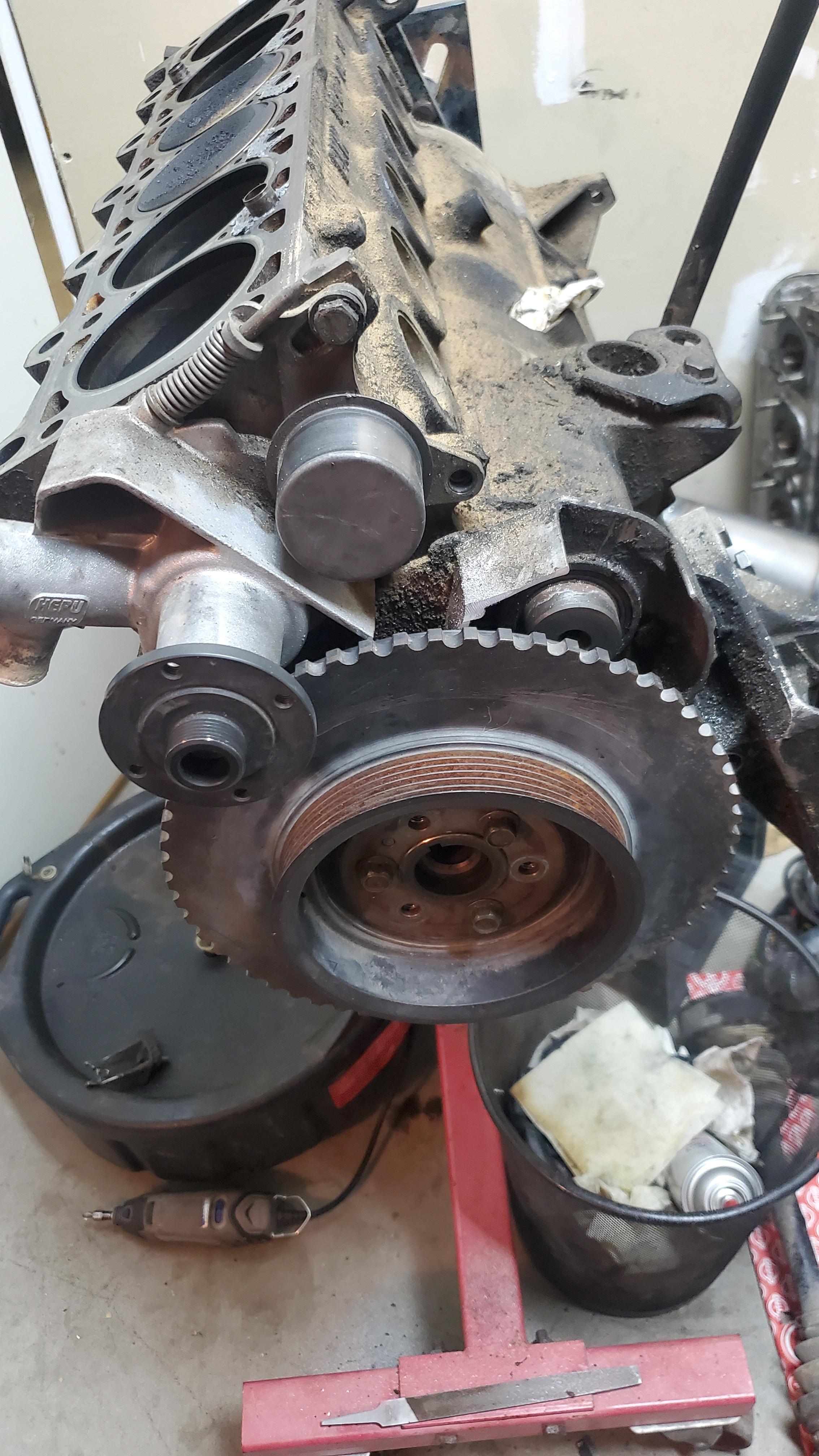
Next on the list is this M50 harmonic balancer conversion. I'm planning on keeping the vbelt for the power steering pump and only converting the water pump and alternator to the multi-v belt. I should be able to run this setup without a sprung tensioner if I keep the belt length short. A true serpentine belt running everything would almost certainly require the works.
I was looking for another M20B25 balancer for this other engine but apparently people got together and decided a 30 year old bonded rubber damper is a $200 part. I'll figure out the M50 conversion before I spend 200 dollars on a junkyard pulley.
Meanwhile the car is solid. Boost is kept down to 10/11 psi on account of the stock clutch. It was slipping bad under boost right after the install but once the 15 years of garage floor dust got scrubbed off its been flawless. Don't want to push it though. I'm holding the line here and trying to avoid installing the big turbo and kevlar clutch I have sitting here for the other project car.
I may do some testing with the turbo, it is directly interchangeable with the GT2560R with the exception of the compressor inlet, I will need to make a new intake pipe and find a suitably large air filter. That's why I like these T25 units, you can bolt on the spoolmeister 2560R or you can bolt on the 2971R with almost twice as much capacity on the turbine side and about 50% more on the compressor. The 2871R sits neatly in between and made very good, very usable power on my original build. They all just bolt right up with the same 5 bolt discharge and connections at the center housing. Whatever power delivery you prefer is easy to achieve.
Re: Turbo ETA build
Updated EAE settings, after much testing and minor revision from the ones I posted in October:
Adhere to walls coefficient (same as October settings):
% Correction
15 1
35 12
40 15
45 18
50 21
55 23
60 25
65 27
70 28
80 29
90 29
100 29
Sucked from walls coefficient (also unchanged):
% Correction
15 .1
35 1.2
40 1.5
45 1.8
50 2.1
55 2.3
60 2.5
65 2.7
70 2.8
80 2.9
90 2.9
100 2.9
Adhere to walls RPM correction:
RPM %
800 100
1000 95
1500 82
2000 70
2500 56
3000 40
3500 26
4000 14
4500 6
5000 2
5500 1
6000 1
Sucked from walls RPM correction:
RPM %
800 53
1000 55
1500 60
2000 64
2500 68
3000 73
3500 80
4000 88
4500 94
5000 98
5500 100
6000 100
Adhere to walls CLT correction:
CLT Correction
0 200
20 200
40 189
60 176
80 162
100 147
120 132
140 115
160 100
170 100
180 100
Sucked from walls CLT correction:
CLT Correction
0 24
20 31
40 38
60 45
80 54
100 63
120 72
130 77
140 83
160 94
170 99
180 100
TPS based AE is as follows:
MAPdot VS TPS blend %: 60% TPS/40% MAP
MAP based AE
kPa/s Added ms
50.0 1.4
125.0 1.6
300.0 2.0
600.0 2.0
Accel MAPdot threshold: 100 kPa/sec
End Pulsewidth: 0.0 ms
Accel time: .1 s
Accel taper time: .8 s
Accel TPSdot Threshold: 20.0 %/sec
Decel fuel amount: 100
Cold accel adder: .6 ms
Cold accel multiplier: 120
Accel scaling: Full accel below 800 RPM, zero accel above 6000 RPM
EAE is not too bad to tune once you understand which variables to manipulate. The constants determine the basic values that the algorithm runs on. The max enrichment is determined by the max values on the added to walls coefficient. If its 29% at 100 kPa, it'll kick in 29% when you quickly open the throttle. The RPM and CLT corrections modify that depending on where it's at on those curves. RPM scales the enrichment down as RPM increases, CLT scales the enrichment up at low temps. Sucked from walls settings affect the most important and beneficial part of this algorithm which pulls fuel when you lift off of the throttle. Since EAE is constantly computing a numerical value to estimate the amount of fuel wetting to the intake port walls, the amount that is pulled off of the walls is crucial to keep the computed value in check. If EAE thinks there is too much or too little fuel in the ports compared to what's actually in there it throws off the whole thing. The balance between added to and sucked from has the greatest effect on drivability. If this balance is out of whack it will be late on the enrichment, resulting in a lean spike and irregular throttle response.
These settings have been tested down into the 20 degree range and the cold start drivability is excellent. I have pulled back almost all of the after start enrichment as this is redundant with EAE, which performs the same task on startup. The tradition time based AE based settings are specific to 30lb/hr injectors so they will need to be adjusted if you're running something different. In my experience, 30lb injectors are a very good choice for MS to get enough fuel in during very cold starts. I don't know what Motronic does to get an M20 to light off with 14 lb injectors unless it's just holding the injectors open while cranking. MS doesn't do that and requires quite a bit more injector to get an engine to light off at 24 degrees.
Otherwise, not much else going on with this thing. I just put gas in it and drive it. Just changed the oil yesterday. I rarely open the hood anymore now that I've gotten to a point where I can trust that the head gasket is holding. I did find a nice set of e90 335i seats locally, so I snapped those up and slapped them in:
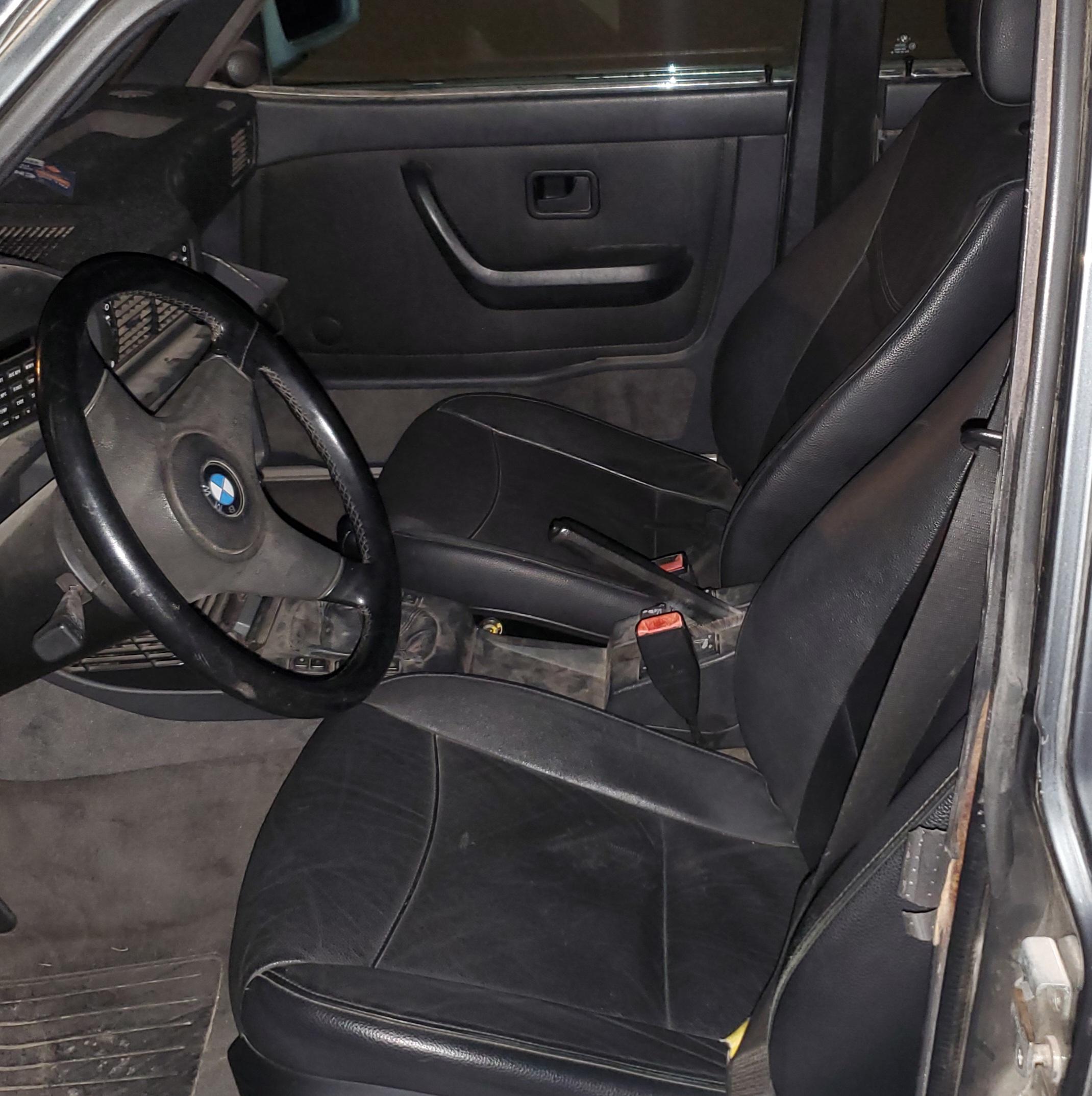
Forgive the dust and dirtyness. It gets everywhere out here, living on dirt roads. These seats are pretty great though, the posterior expects the familiar sacked out and deteriorated e28 seat, but each time I get in I'm greeted by this firm, supportive and very comfortable new upholstery. It's a surprise every time. I need to address the driver's seat controls however, apparently the seat module requires a data line signal to stay awake. it operates for about ten seconds once power is connected, plenty of time to adjust your seat, but then it goes to sleep. I think the easiest solution here is going to be supplying the seat with a switched 12v, perhaps from the rear window circuit interrupt switch. That way I can switch power on at the push of a button, adjust the seat as needed, and switch power off again until the next time I want to move the seat. It's not something you need to do very often anyway.
Adhere to walls coefficient (same as October settings):
% Correction
15 1
35 12
40 15
45 18
50 21
55 23
60 25
65 27
70 28
80 29
90 29
100 29
Sucked from walls coefficient (also unchanged):
% Correction
15 .1
35 1.2
40 1.5
45 1.8
50 2.1
55 2.3
60 2.5
65 2.7
70 2.8
80 2.9
90 2.9
100 2.9
Adhere to walls RPM correction:
RPM %
800 100
1000 95
1500 82
2000 70
2500 56
3000 40
3500 26
4000 14
4500 6
5000 2
5500 1
6000 1
Sucked from walls RPM correction:
RPM %
800 53
1000 55
1500 60
2000 64
2500 68
3000 73
3500 80
4000 88
4500 94
5000 98
5500 100
6000 100
Adhere to walls CLT correction:
CLT Correction
0 200
20 200
40 189
60 176
80 162
100 147
120 132
140 115
160 100
170 100
180 100
Sucked from walls CLT correction:
CLT Correction
0 24
20 31
40 38
60 45
80 54
100 63
120 72
130 77
140 83
160 94
170 99
180 100
TPS based AE is as follows:
MAPdot VS TPS blend %: 60% TPS/40% MAP
MAP based AE
kPa/s Added ms
50.0 1.4
125.0 1.6
300.0 2.0
600.0 2.0
Accel MAPdot threshold: 100 kPa/sec
End Pulsewidth: 0.0 ms
Accel time: .1 s
Accel taper time: .8 s
Accel TPSdot Threshold: 20.0 %/sec
Decel fuel amount: 100
Cold accel adder: .6 ms
Cold accel multiplier: 120
Accel scaling: Full accel below 800 RPM, zero accel above 6000 RPM
EAE is not too bad to tune once you understand which variables to manipulate. The constants determine the basic values that the algorithm runs on. The max enrichment is determined by the max values on the added to walls coefficient. If its 29% at 100 kPa, it'll kick in 29% when you quickly open the throttle. The RPM and CLT corrections modify that depending on where it's at on those curves. RPM scales the enrichment down as RPM increases, CLT scales the enrichment up at low temps. Sucked from walls settings affect the most important and beneficial part of this algorithm which pulls fuel when you lift off of the throttle. Since EAE is constantly computing a numerical value to estimate the amount of fuel wetting to the intake port walls, the amount that is pulled off of the walls is crucial to keep the computed value in check. If EAE thinks there is too much or too little fuel in the ports compared to what's actually in there it throws off the whole thing. The balance between added to and sucked from has the greatest effect on drivability. If this balance is out of whack it will be late on the enrichment, resulting in a lean spike and irregular throttle response.
These settings have been tested down into the 20 degree range and the cold start drivability is excellent. I have pulled back almost all of the after start enrichment as this is redundant with EAE, which performs the same task on startup. The tradition time based AE based settings are specific to 30lb/hr injectors so they will need to be adjusted if you're running something different. In my experience, 30lb injectors are a very good choice for MS to get enough fuel in during very cold starts. I don't know what Motronic does to get an M20 to light off with 14 lb injectors unless it's just holding the injectors open while cranking. MS doesn't do that and requires quite a bit more injector to get an engine to light off at 24 degrees.
Otherwise, not much else going on with this thing. I just put gas in it and drive it. Just changed the oil yesterday. I rarely open the hood anymore now that I've gotten to a point where I can trust that the head gasket is holding. I did find a nice set of e90 335i seats locally, so I snapped those up and slapped them in:

Forgive the dust and dirtyness. It gets everywhere out here, living on dirt roads. These seats are pretty great though, the posterior expects the familiar sacked out and deteriorated e28 seat, but each time I get in I'm greeted by this firm, supportive and very comfortable new upholstery. It's a surprise every time. I need to address the driver's seat controls however, apparently the seat module requires a data line signal to stay awake. it operates for about ten seconds once power is connected, plenty of time to adjust your seat, but then it goes to sleep. I think the easiest solution here is going to be supplying the seat with a switched 12v, perhaps from the rear window circuit interrupt switch. That way I can switch power on at the push of a button, adjust the seat as needed, and switch power off again until the next time I want to move the seat. It's not something you need to do very often anyway.
-
M. Holtmeier
- Posts: 3036
- Joined: Mar 11, 2007 3:06 AM
- Location: Josephine, Texas
Re: Turbo ETA build
This is great info, thanks for sharing.
Re: Turbo ETA build
Knocked off an e60 M5 this afternoon. I wonder if he was in p500 or the 400hp mode. Either way, third gear handled that thing with ease. He just went ahead and jumped, I gave chase and walked past pretty swiftly. Safe to say it was an ass whopping.
I had to do the math on this one, I expected more of a challenge. A brief internet search reveals a 4100 pound curb weight. I've got a roughly 1200lb advantage here alone. Horsepower wise, the 507 hp of that S85 translates to about 431 at the wheels at sea-level. Up here it's down another 20 percent, so we can knock that down to 345 rear wheel. I should be in the neighborhood of 240-250 rear wheel at this boost level, but if we account for the weight difference we should be a very close match up. A 4100lb car with 345 rear wheel is right on par with a 2900lb car with 245.
If this guy was in the lower power mode, an e28 with 190 rear wheel should keep up with it. Considering the results, it seems very likely that this guy thought that would be enough. Despite the jump and me starting relatively slow for 3rd, the e60 was several carlengths behind when I shut it down.
High altitude is a real bitch with NA motors. My previous experiences, such as the C6 Z06 in the original turbo car, bear this out time and time again.
I had to do the math on this one, I expected more of a challenge. A brief internet search reveals a 4100 pound curb weight. I've got a roughly 1200lb advantage here alone. Horsepower wise, the 507 hp of that S85 translates to about 431 at the wheels at sea-level. Up here it's down another 20 percent, so we can knock that down to 345 rear wheel. I should be in the neighborhood of 240-250 rear wheel at this boost level, but if we account for the weight difference we should be a very close match up. A 4100lb car with 345 rear wheel is right on par with a 2900lb car with 245.
If this guy was in the lower power mode, an e28 with 190 rear wheel should keep up with it. Considering the results, it seems very likely that this guy thought that would be enough. Despite the jump and me starting relatively slow for 3rd, the e60 was several carlengths behind when I shut it down.
High altitude is a real bitch with NA motors. My previous experiences, such as the C6 Z06 in the original turbo car, bear this out time and time again.
-
Nebraska_e28
- Beamter

- Posts: 9071
- Joined: Apr 13, 2006 11:18 PM
- Location: Council Bluffs, IA
- Contact:
Re: Turbo ETA build
Sounds like the car is running VERY well!
Re: Turbo ETA build
This is why I am building B35 for altitude. I am at a similar elevation but it really makes a difference as you go up to 10,000+ ft!turbodan wrote: Feb 27, 2024 11:11 PM High altitude is a real bitch with NA motors. My previous experiences, such as the C6 Z06 in the original turbo car, bear this out time and time again.
Mainly B35 turbo over B34 turbo for better throttle response and reduced boost lag with the higher compression. I'll likely run a similar overall power level but lower boost setting as well just for reliability.
I have added your AAE settings to my tune but haven't tried them yet.I am going to see about upping my req_fuel setting to try to get my fuel table closer to 200 for maybe slightly better precision than in the 8's. I only have MS2 where in MS3 you can tune the fuel table to .1 digits, I am stuck with integer number and I think this is a bit of a sacrifice in fueling precision.
Re: Turbo ETA build
I guess I can imagine situations where decimal precision would be handy on the fuel table. I stick to whole numbers on the ignition map too, where I actually do have the ability to tune to the tenths.
I have slightly updated my EAE settings, I'll have to post those up. I turned the sucked from walls RPM curve down a bit and it works a little better in the 2k-3k range. I'm still not entirely happy with TPS based AE, could be a little snappier dipping into the throttle at idle but it drives perfectly so this is a low priority.
I have slightly updated my EAE settings, I'll have to post those up. I turned the sucked from walls RPM curve down a bit and it works a little better in the 2k-3k range. I'm still not entirely happy with TPS based AE, could be a little snappier dipping into the throttle at idle but it drives perfectly so this is a low priority.
-
Nebraska_e28
- Beamter

- Posts: 9071
- Joined: Apr 13, 2006 11:18 PM
- Location: Council Bluffs, IA
- Contact:
Re: Turbo ETA build
Got dyno? 
Re: Turbo ETA build
I should do that. I feel like it's running better than the 2007 build did with the blow through AFM, motronic and an undersized intercooler.
If this car ends up for sale, which is the plan at some point, a dyno sheet is a nice bonus.
If this car ends up for sale, which is the plan at some point, a dyno sheet is a nice bonus.
Re: Turbo ETA build
It's been a bit over a year now, I just realized that the other day. Still holding out with this small turbo at low boost, not pushing my luck and enjoying it for what it is. A dirty, dusty daily driver:
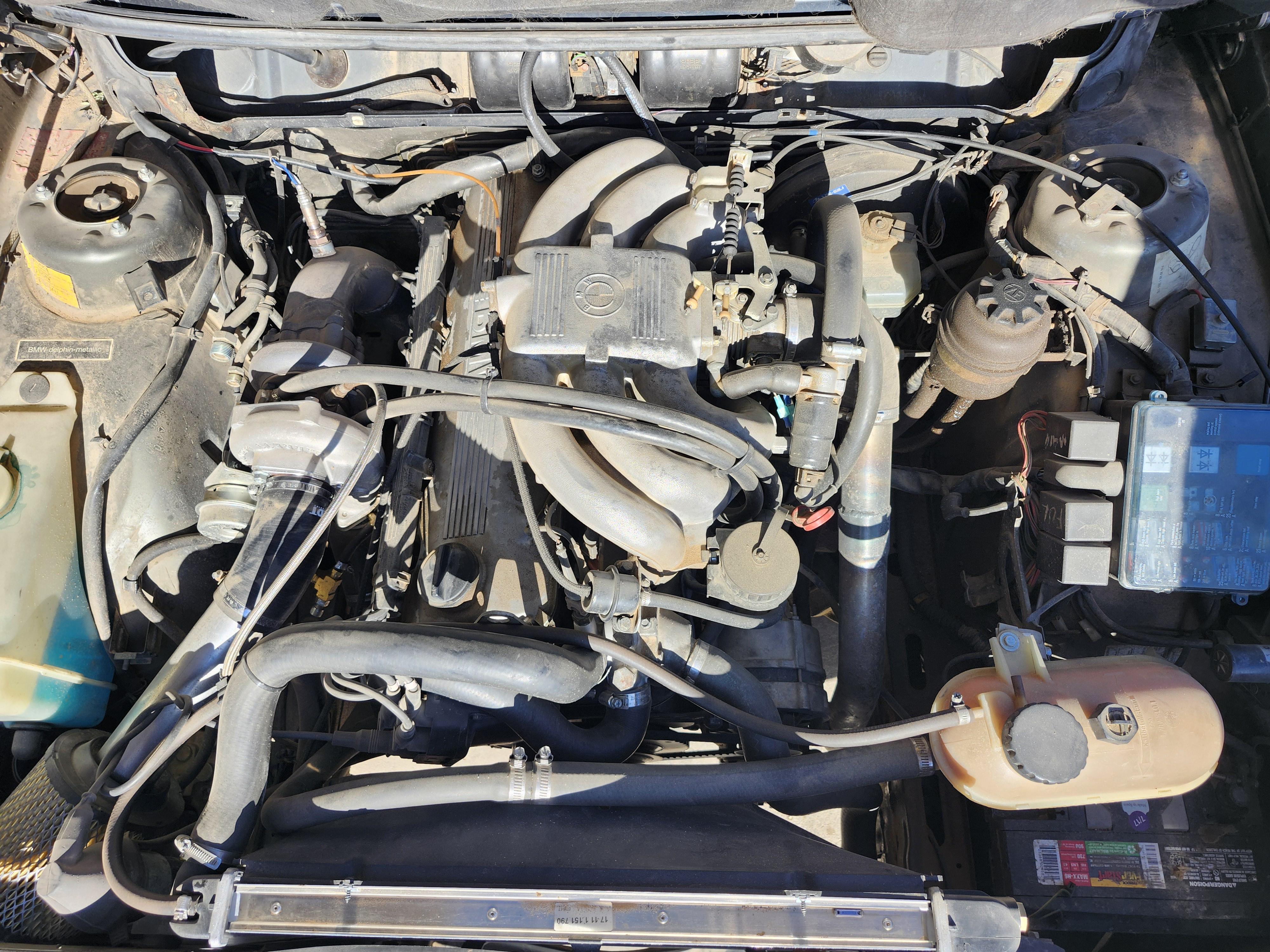
I did improve the air filter. I had a paper filter element from a dodge, perhaps a neon, which fit well and I assumed would work adequately. Unfortunately with the moon dust we have out here it proved to be insufficient. It filters out most of it but I still find dust upstream. This is not acceptable, so I constructed this apparatus around a Honda Element/CR-V air filter:
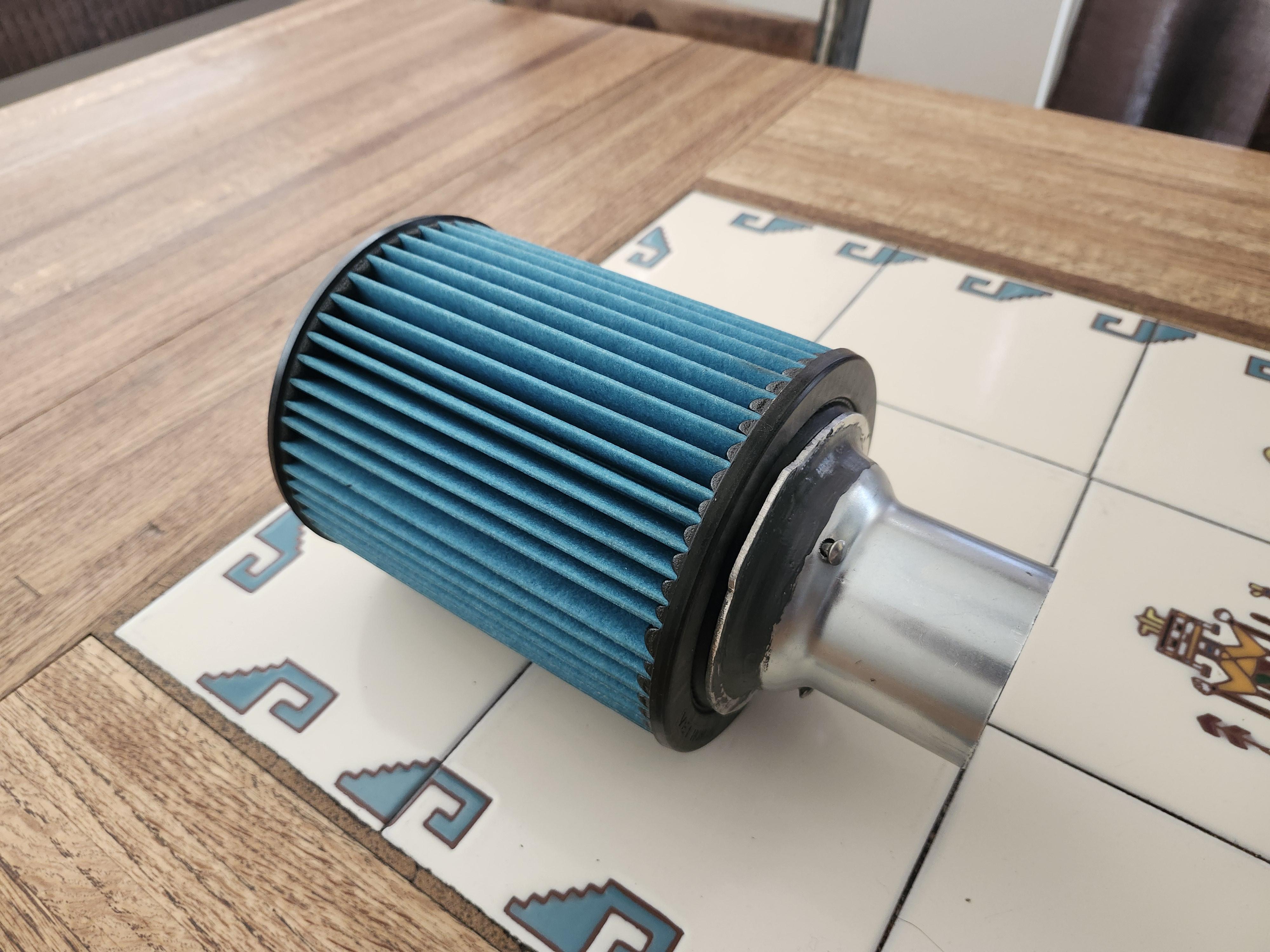
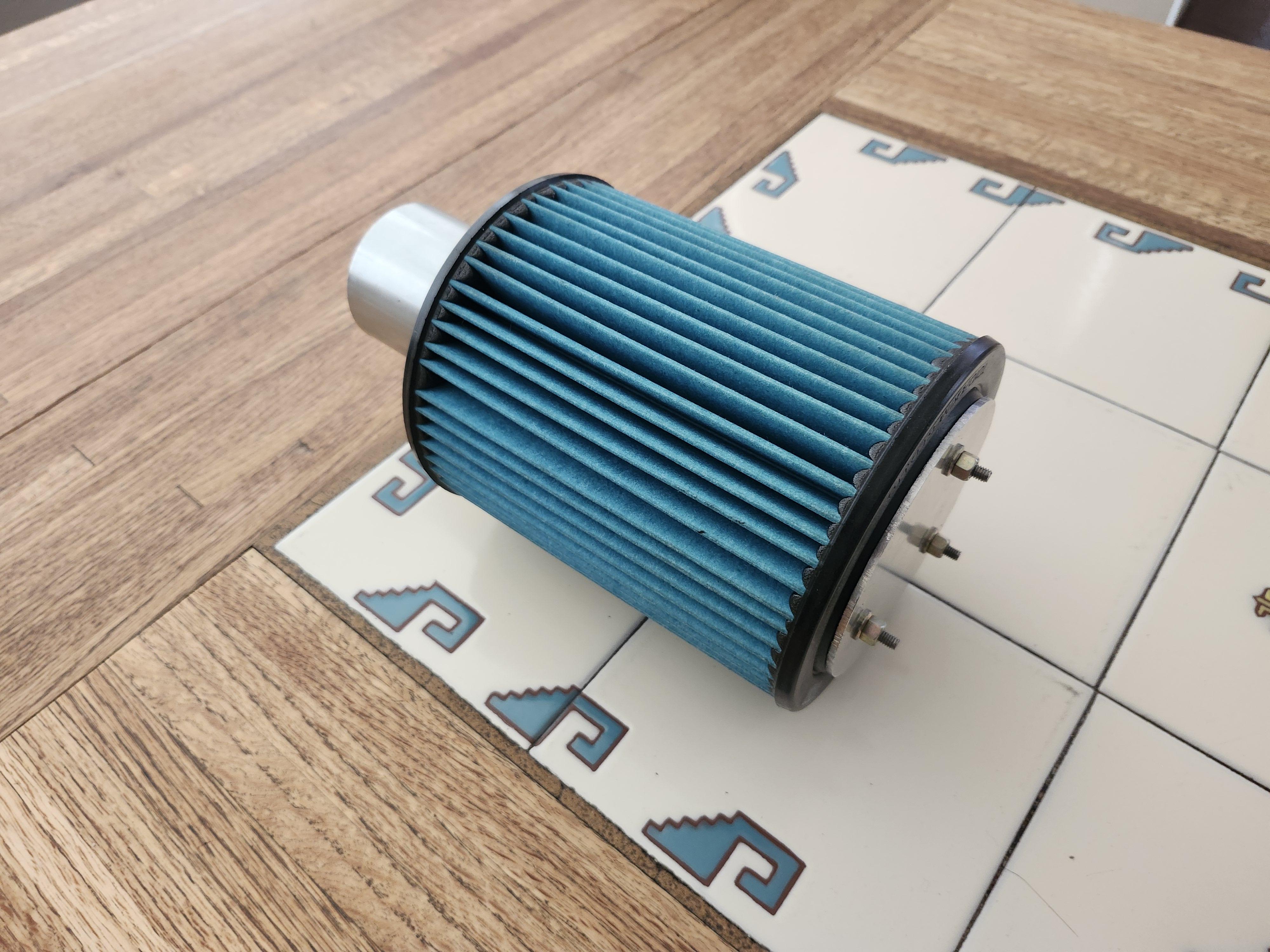
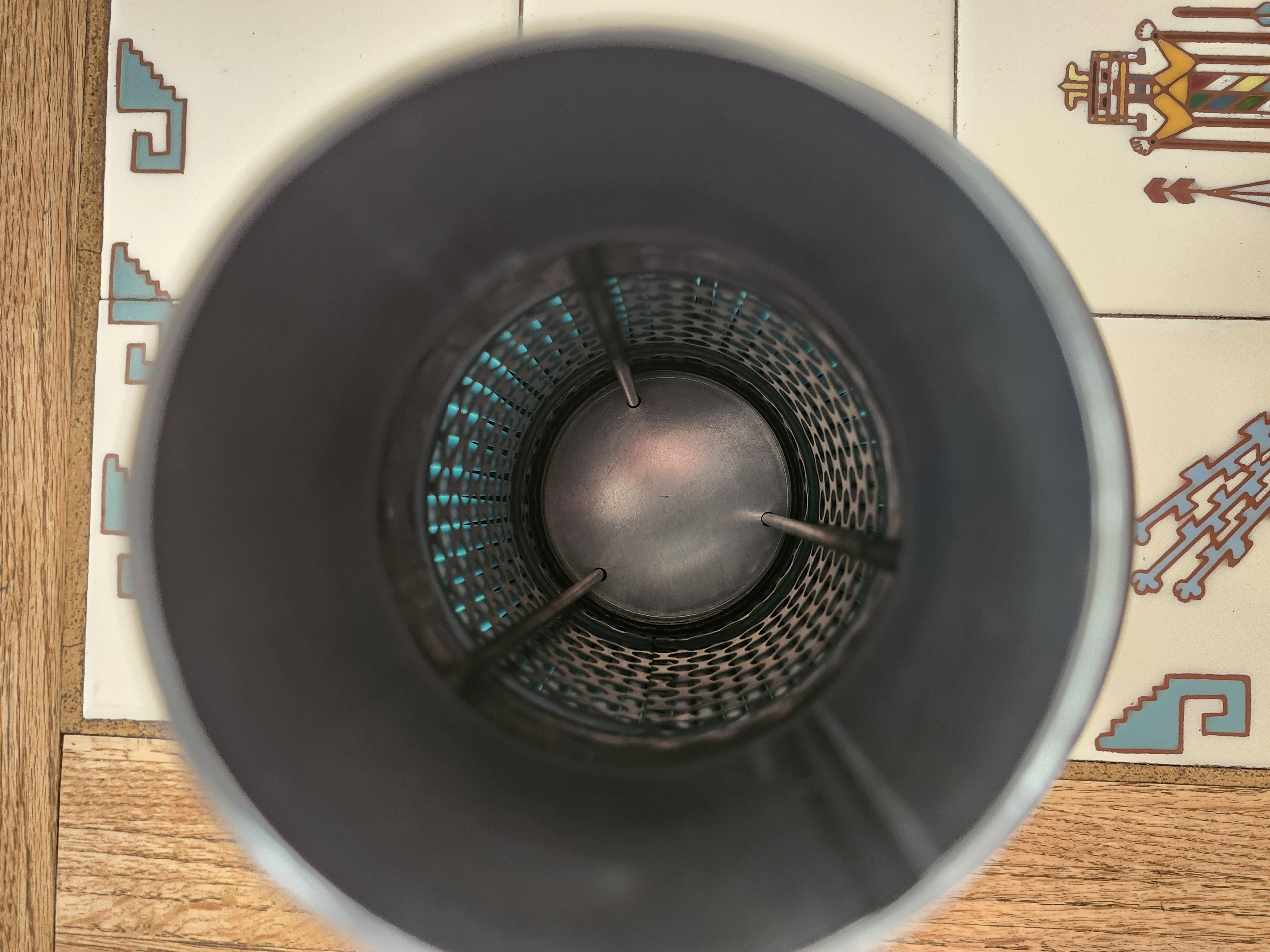
It is a large, cylindrical element consisting of a perforated metal core wrapped with a copius amount of thick, pleated, oiled filter media. The inner diameter is about 81mm and it is open on both ends, necessitating an end cap. I had some straight pull spokes laying around so I used those to hold the assembly together and clamp down against the sealing surfaces on both ends. These are available cheaply at any honda dealer and will support a butt load of air flow. The lightly oiled filter media will catch anything and everything, even better than a high quality paper filter. I highly recommend it.

I did improve the air filter. I had a paper filter element from a dodge, perhaps a neon, which fit well and I assumed would work adequately. Unfortunately with the moon dust we have out here it proved to be insufficient. It filters out most of it but I still find dust upstream. This is not acceptable, so I constructed this apparatus around a Honda Element/CR-V air filter:



It is a large, cylindrical element consisting of a perforated metal core wrapped with a copius amount of thick, pleated, oiled filter media. The inner diameter is about 81mm and it is open on both ends, necessitating an end cap. I had some straight pull spokes laying around so I used those to hold the assembly together and clamp down against the sealing surfaces on both ends. These are available cheaply at any honda dealer and will support a butt load of air flow. The lightly oiled filter media will catch anything and everything, even better than a high quality paper filter. I highly recommend it.
-
Nebraska_e28
- Beamter

- Posts: 9071
- Joined: Apr 13, 2006 11:18 PM
- Location: Council Bluffs, IA
- Contact:
Re: Turbo ETA build
That should work well! Looks big enough to be a truck filter. 
Re: Turbo ETA build
It's huge considering it's original application. Much more appropriate on something like this which requires far greater air flow than the 2.4l Honda.
I was surprised to find that I had to make adjustments to the fuel table with the new filter. Had to add fuel especially under boost. The old filter was apparently undersized to the point of inefficiency.
I really should dyno it just for kicks. Minimum 230 rear wheel, I would guess 250 max as it sits now at .5 bar. As Todd mentioned long ago, they make a predictable amount of power, something like 11rwhp per pound of boost. I guess the question is what kind of boost I want to run it at. Perhaps .8 bar would be interesting, if the clutch will hold.
.8 bar would be about 11.5 psi. If the predicted power is achieved it would make about 285 rear wheel, comparable to a strong S54. I know this turbo is increasingly inefficient at higher boost but it'll certainly make the boost.
I've also been thinking about swapping the turbo cam back in. That head is complete and ready to install, would definitely make for a more interesting dyno than a re-run of the original.
I was surprised to find that I had to make adjustments to the fuel table with the new filter. Had to add fuel especially under boost. The old filter was apparently undersized to the point of inefficiency.
I really should dyno it just for kicks. Minimum 230 rear wheel, I would guess 250 max as it sits now at .5 bar. As Todd mentioned long ago, they make a predictable amount of power, something like 11rwhp per pound of boost. I guess the question is what kind of boost I want to run it at. Perhaps .8 bar would be interesting, if the clutch will hold.
.8 bar would be about 11.5 psi. If the predicted power is achieved it would make about 285 rear wheel, comparable to a strong S54. I know this turbo is increasingly inefficient at higher boost but it'll certainly make the boost.
I've also been thinking about swapping the turbo cam back in. That head is complete and ready to install, would definitely make for a more interesting dyno than a re-run of the original.
Re: Turbo ETA build
I found this thread trying to figure out what flange size the 524td manifold I have sitting on the shelf is. Killer work- this reminds me of old r3v
Re: Turbo ETA build
Best to measure it, there are t25 and t3 varieties. The most common is the AGR manifold with the t3 flange.blue91lx wrote: Jul 13, 2024 9:13 AM I found this thread trying to figure out what flange size the 524td manifold I have sitting on the shelf is. Killer work- this reminds me of old r3v
Re: Turbo ETA build
I decided it's time to push my luck a little bit. I figure, if I'm going to swap the head out and put the turbo cam back in, I will be replacing the head gasket either way. Might as well push some more boost through and see how much the stock clutch and head gasket will withstand.
The option at hand is a garrett 12-14 psi wastegate actuator. I removed it from my GT2971R that's been literally sitting on top of my dresser for the last year and bolted it onto the GT2560R. Minor slotting of the bolt holes was required. I prefer this over the ball and spring MBC as the MBC always spikes on spoolup and settles toward equilibrium. A higher pressure wastegate with nothing interfering with the signal line operates more consistently.
The tension on the actuator rod is adjustable, and I may dial it down a bit, as it is currently hitting a maximum of ~175 kpa, or 13.6 psi above atmospheric. This little Garrett is doing the best it can but it does drop off a bit toward the top end, down to about 10.5 by 6k. The pull from the bottom end and midrange is excellent, and despite the drop in boost the top end is not bad either. I don't need to short shift it, it definitely pulls all the way up.
We'll see how it does. The datalog shows only wheelspin, no clutch slippage. This is the same stock 528e clutch that I took out of a parts car about 15 years ago and had sitting on my garage floor until installation late last year. Slipped badly at first, and I was bummed, but after a few drives it came alive again and it's been great since.
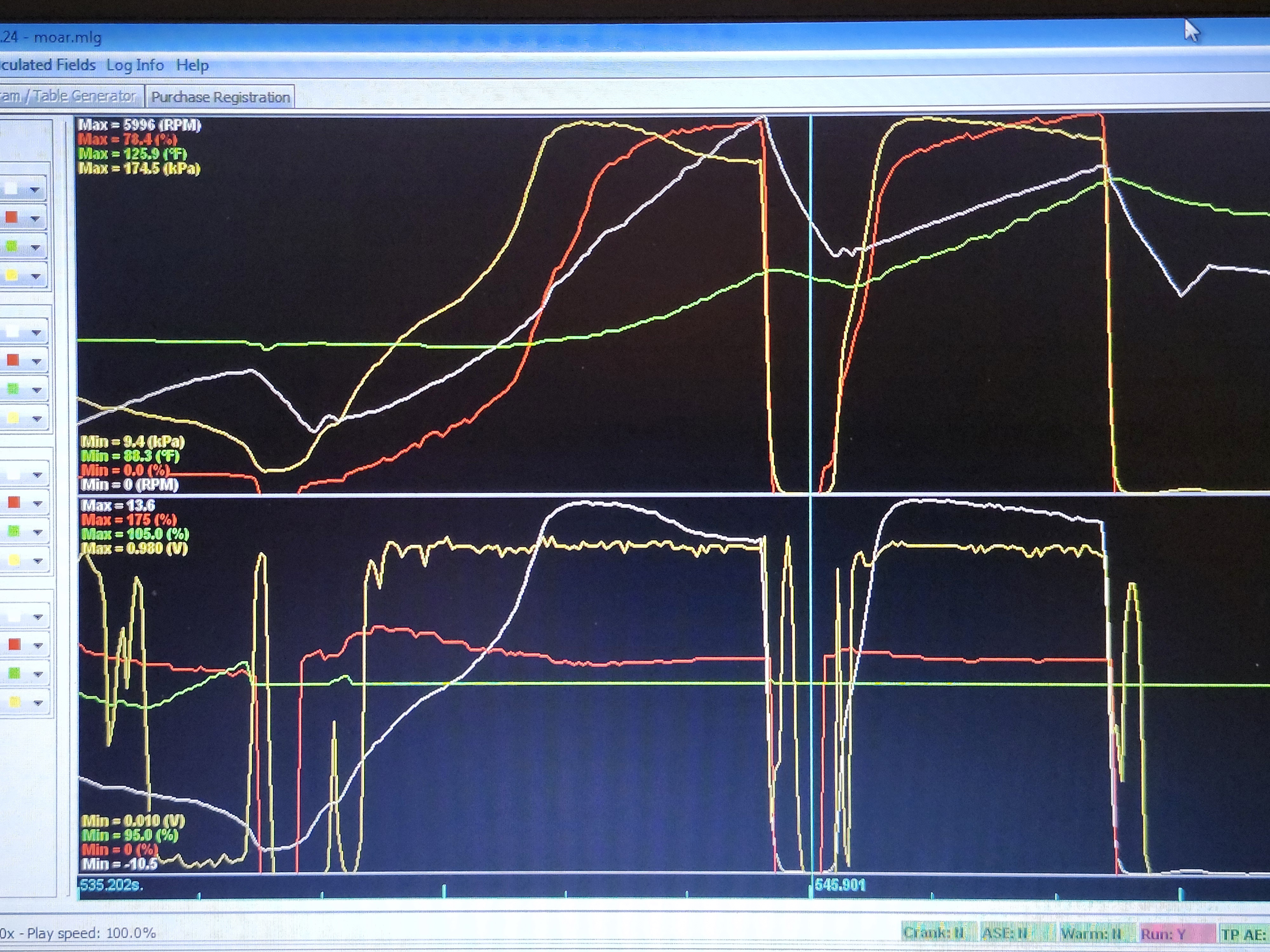
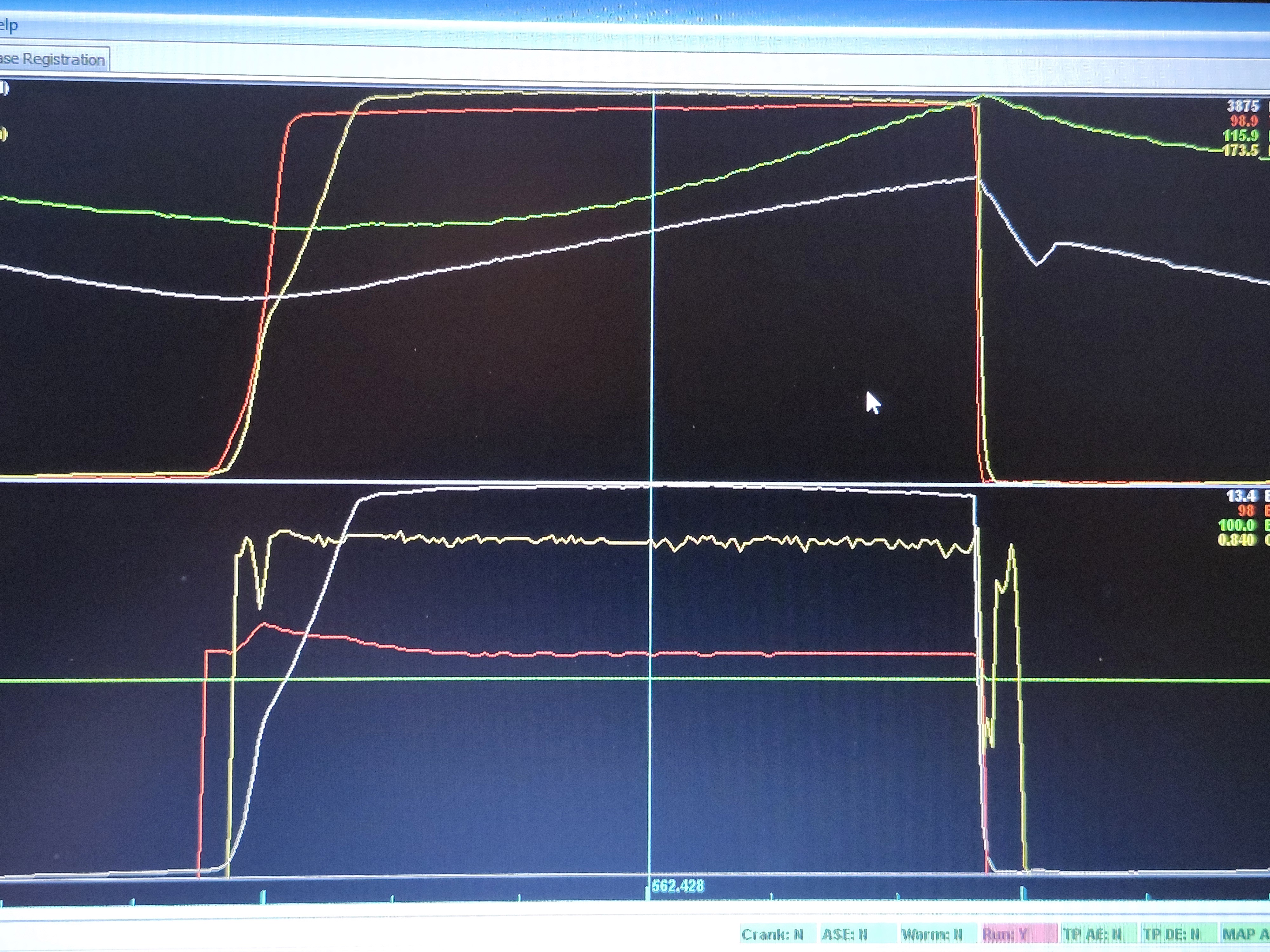
The option at hand is a garrett 12-14 psi wastegate actuator. I removed it from my GT2971R that's been literally sitting on top of my dresser for the last year and bolted it onto the GT2560R. Minor slotting of the bolt holes was required. I prefer this over the ball and spring MBC as the MBC always spikes on spoolup and settles toward equilibrium. A higher pressure wastegate with nothing interfering with the signal line operates more consistently.
The tension on the actuator rod is adjustable, and I may dial it down a bit, as it is currently hitting a maximum of ~175 kpa, or 13.6 psi above atmospheric. This little Garrett is doing the best it can but it does drop off a bit toward the top end, down to about 10.5 by 6k. The pull from the bottom end and midrange is excellent, and despite the drop in boost the top end is not bad either. I don't need to short shift it, it definitely pulls all the way up.
We'll see how it does. The datalog shows only wheelspin, no clutch slippage. This is the same stock 528e clutch that I took out of a parts car about 15 years ago and had sitting on my garage floor until installation late last year. Slipped badly at first, and I was bummed, but after a few drives it came alive again and it's been great since.


-
Nebraska_e28
- Beamter

- Posts: 9071
- Joined: Apr 13, 2006 11:18 PM
- Location: Council Bluffs, IA
- Contact:
Re: Turbo ETA build
How far to the local dyno?
The graph looks pretty solid overall.
The graph looks pretty solid overall.
Re: Turbo ETA build
About 25 miles, hopefully they're still there. It's been a while...
Re: Turbo ETA build
Never did get to the dyno, but I do have revised EAE settings. The previous settings worked well in conjunction with significant TPS based enrichment. When I take the TPS based AE out they don't work well at all, so I thought I would try to improve the performance of EAE on its own.
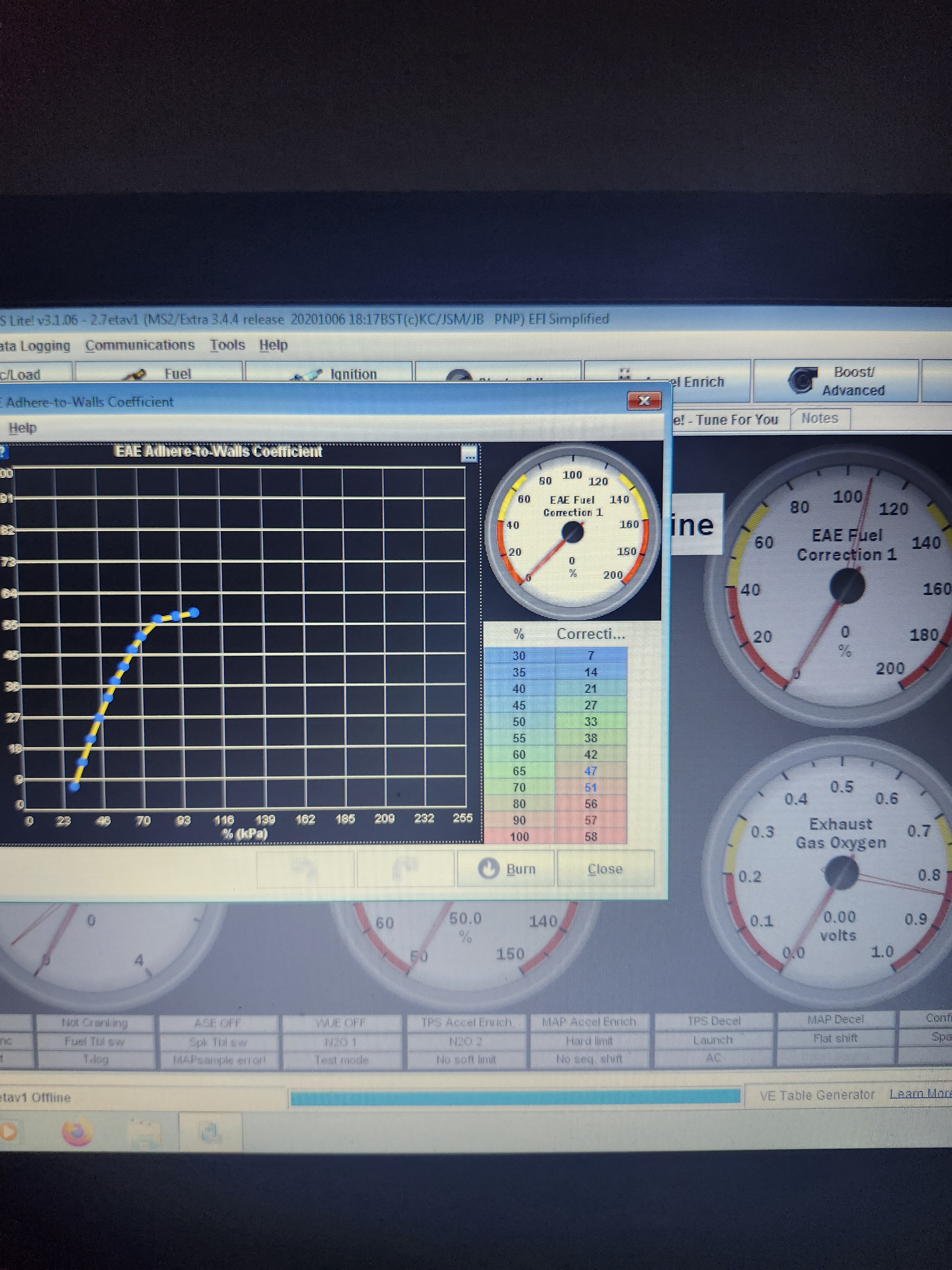
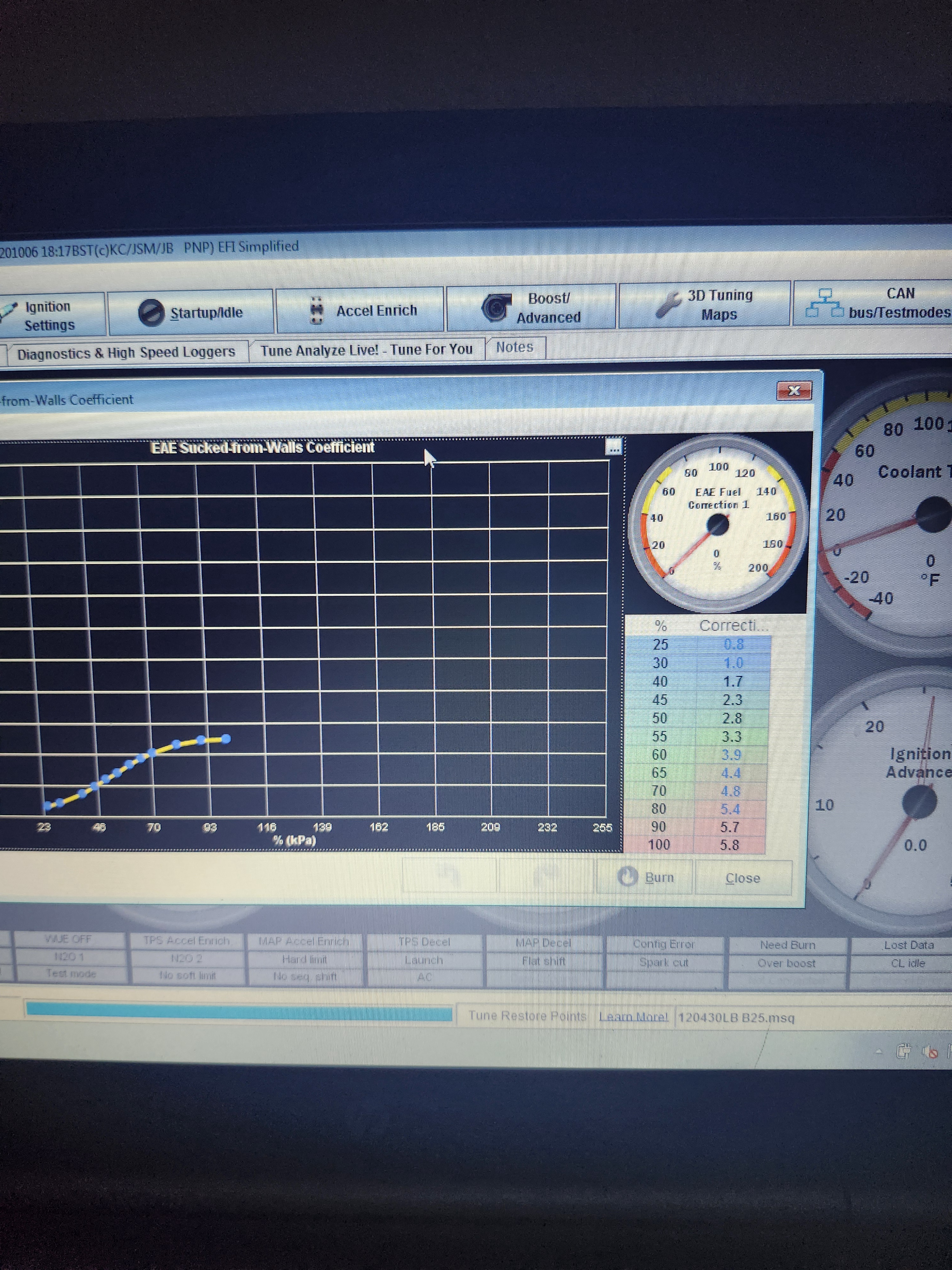
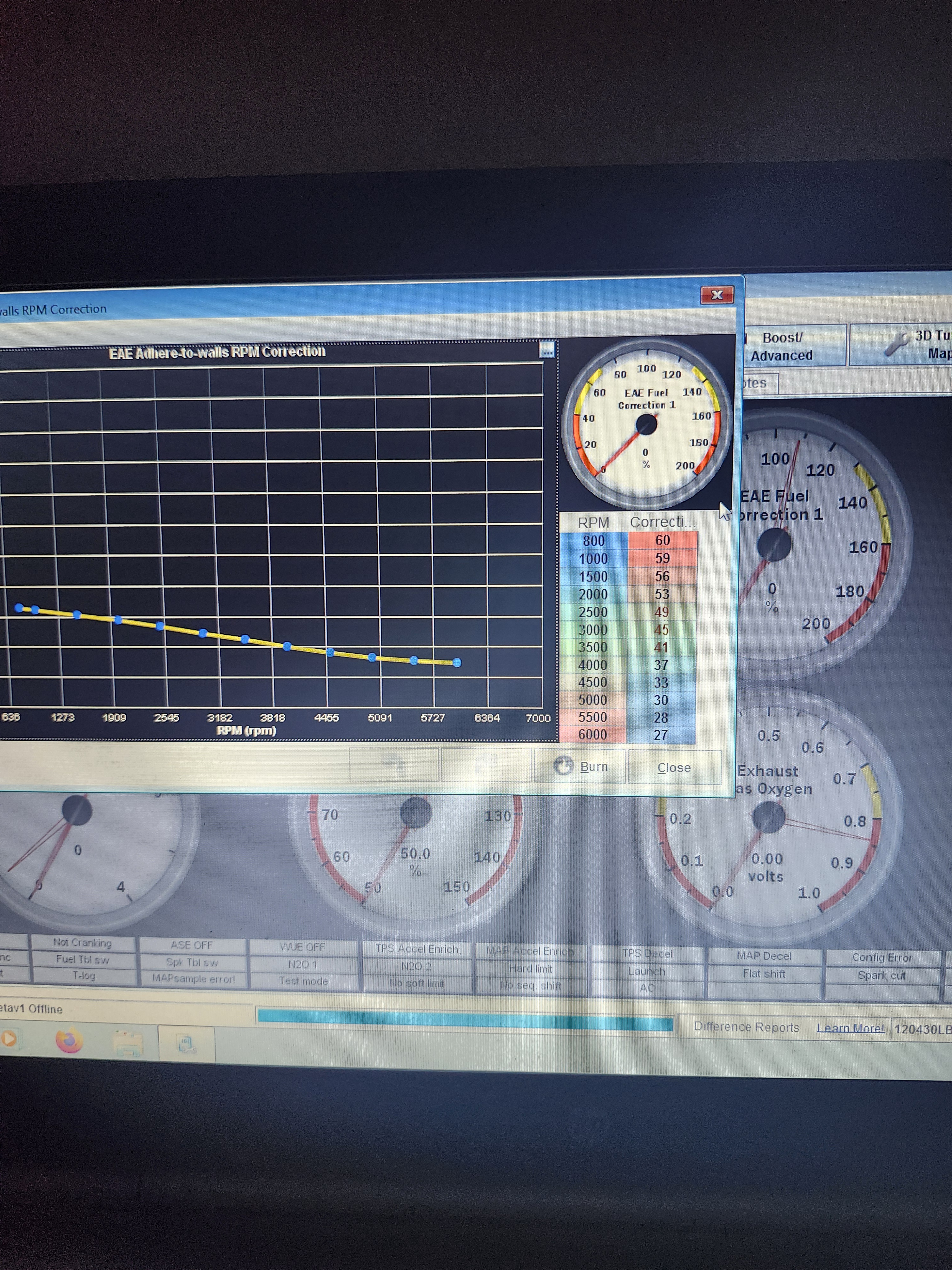
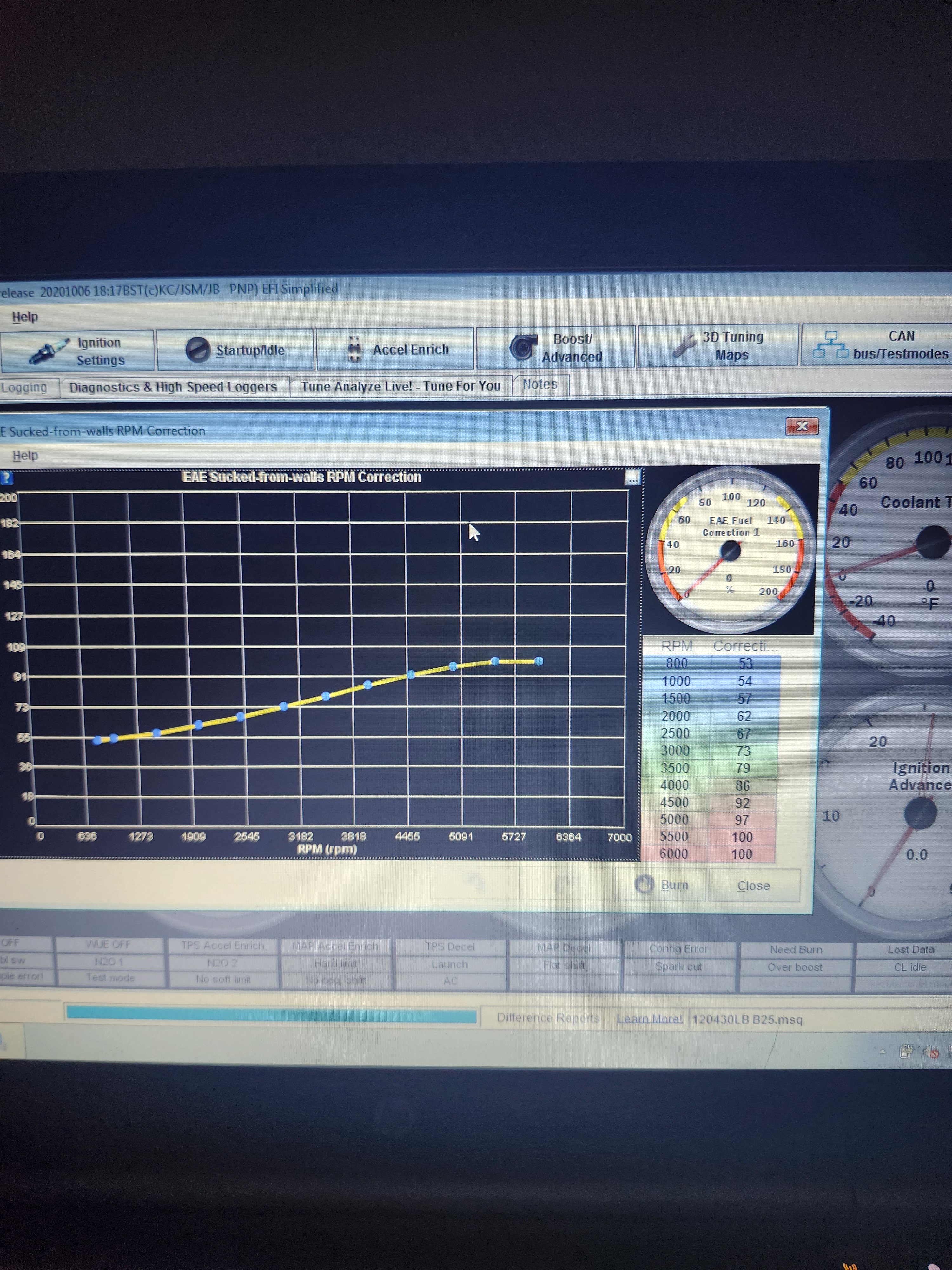
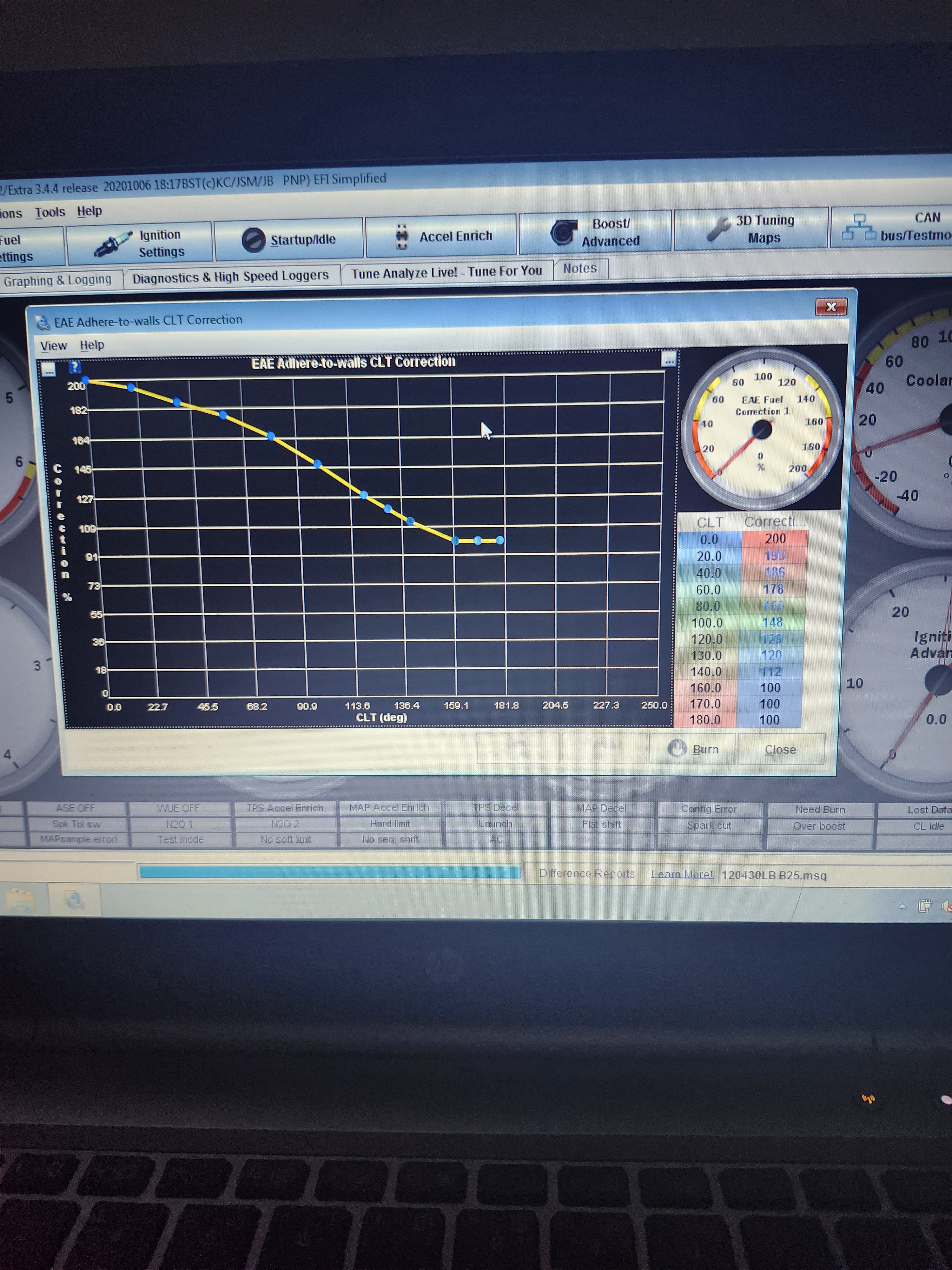
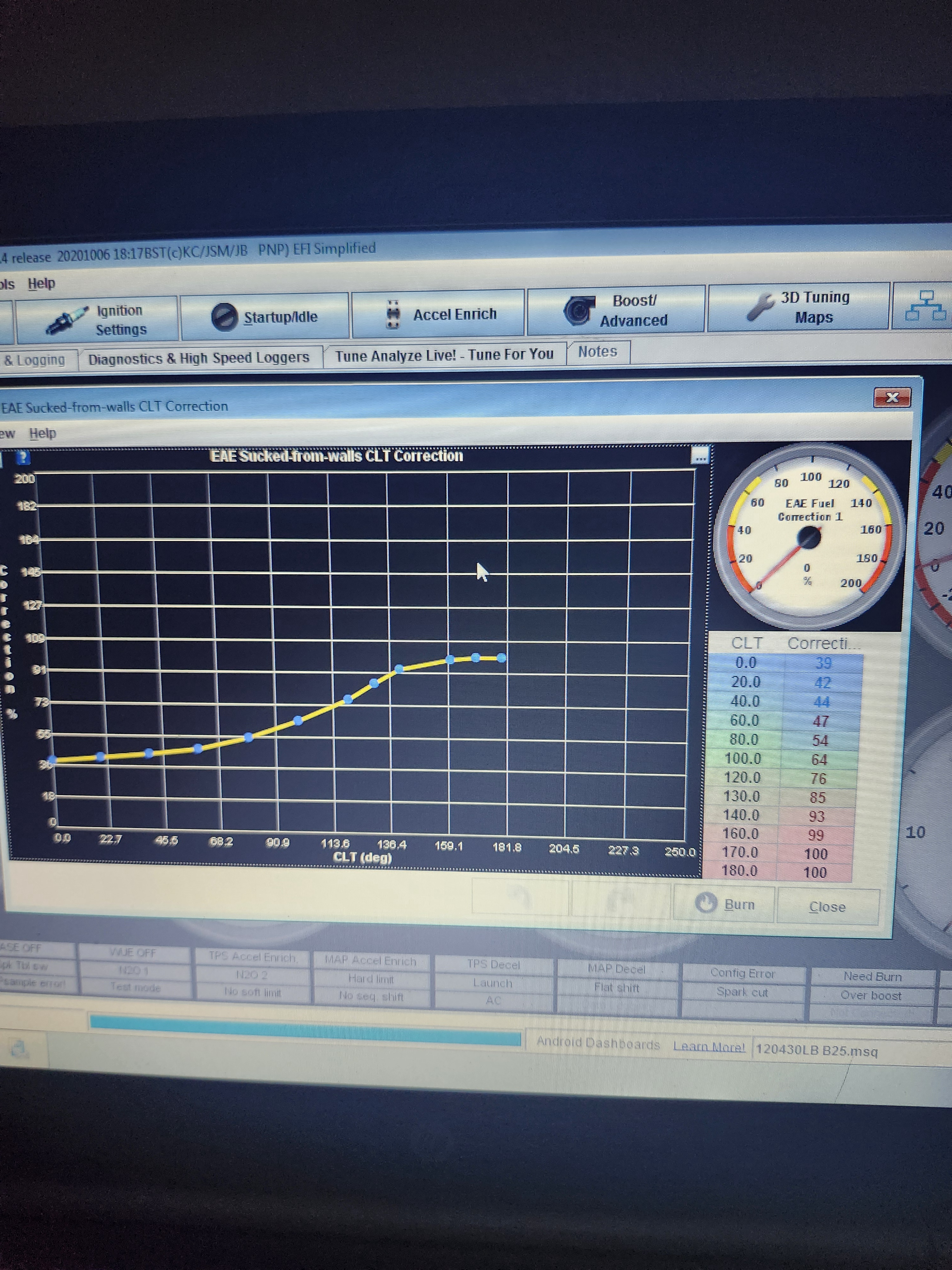
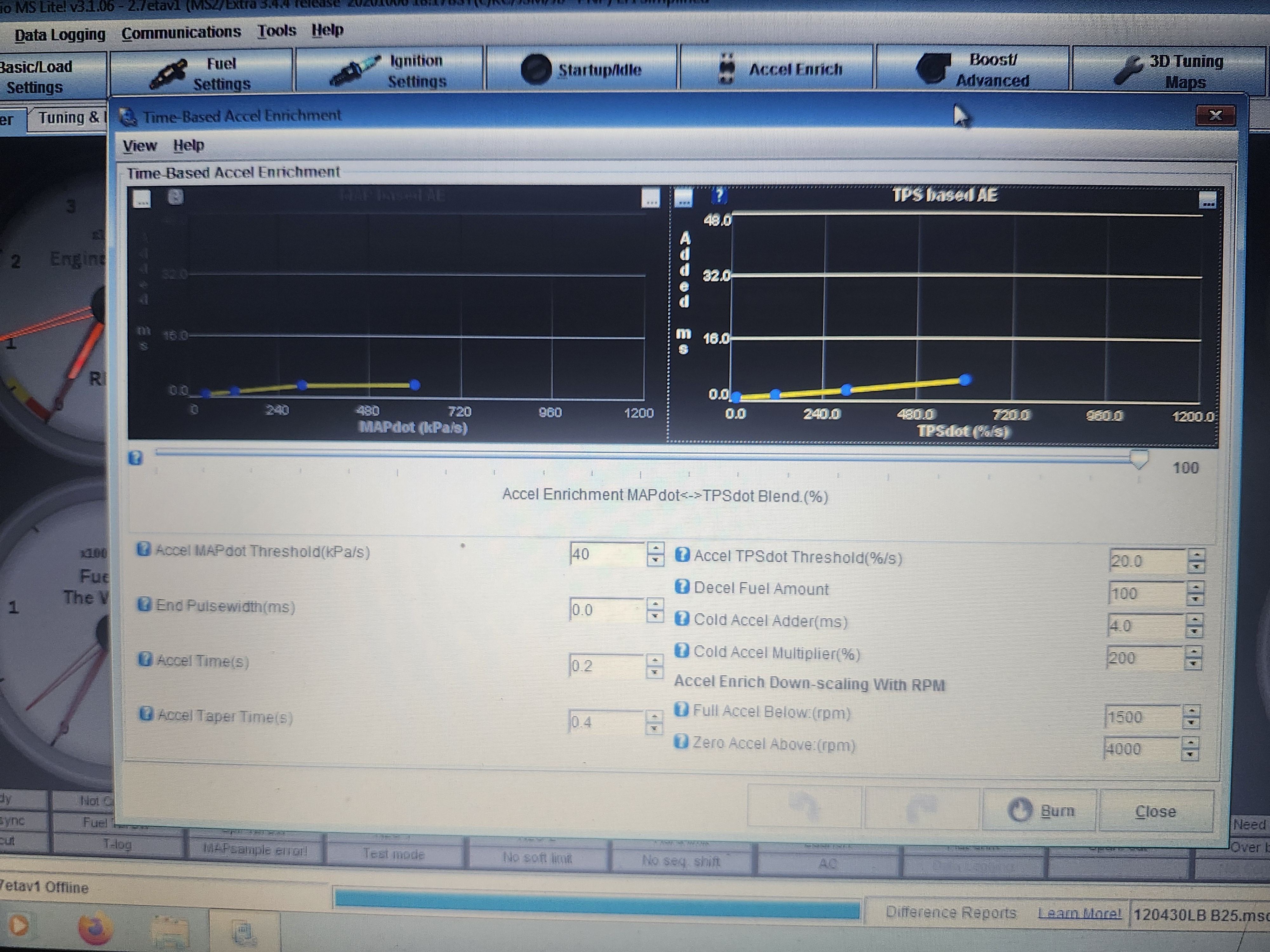
I believe there is an inherent flaw in the EAE code that causes a bit of an issue during warm up. The way I understand EAE, it is calculating a numerical value to represent the amount of fuel pooling in the intake port. It does not factor in what I would call "lost fuel", this is fuel that remains liquid and does not vaporize and combust. This fuel metered by EAE and counted as "fuel on the walls" has in fact been drawn from the port walls and gone through the engine, but EAE still sees it on the port walls.
This is a problem because EAE doesn't work unless you are adding or removing fuel from the wall fuel pool. To add in the required enrichment after a cold start as you drive away, EAE must see a bunch of fuel being added to the walls and it will kick in that much extra to maintain a stable AFR. Since EAE doesn't have a correction factor for "lost fuel", the wall fuel value bloats out of control when cold as EAE assumes a massive amount of fuel is accumulating on the walls. This results in inappropriate corrections in both directions, not enough on tip in and too much correction as you lift off of the throttle. As the engine warms, the fuel vaporizes more readily, the lost fuel factor becomes negligible and the algorithm works as it should. The trick has been finding coolant temp correction settings that make this work without being able to factor in the lost fuel, and I think these settings are about as good as it gets. Moderate throttle movements are recommended, just drive like the engine is cold which you should be doing anyway. When warm, it drives very well with much less TPS based AE than before. TPS AE is perfect for cold starts and low coolant temps, but I don't know if there's a way I can configure it so it provides the necessary boost when cold without providing excessive enrichment when the engine is warm and EAE is up and running.
What a monster to tune though. You can never isolate a variable. Not enough enrichment on tip in is often caused by an insufficient "sucked from walls" setting. If it didn't take enough off of the walls during a gearshift, from the time you lifted off the throttle until you stepped back into it, it will think there's more fuel on the walls than there is and it will apply insufficient enrichment on the next tip in. Balancing added to and sucked from is crucial. Any time the wall fuel total starts to get unreasonably big, it's going to make unreasonable corrections. What constitutes close enough has to be nearly impeccable.
The biggest change in my strategy was to abandon any attempt to maintain a relationship between the "added to" and "sucked from" curves relative to each other. It helps to increase the "sucked from" coefficient at low kpa, you may notice that my curve now bends upward at low kpa. This helps with response on upshifts where it only has a brief period to pull fuel from the walls before it needs to add enrichment again. It should be pulling fuel from the walls, under a strong vacuum the fuel is encouraged to vaporize.
Other than all that, the car has been running great. No issues with the head gasket or clutch, despite having turned the boost up. It was hitting a little over 1 bar on spoolup, but this little turbine is having a hard time maintaining full boost past 5000 RPM. It dips to about .8 bar and holds that the rest of the way up. I am seriously considering a GT2860R or GT2860RS with a .86 AR turbine. Could go with another GT2871R .86. You can feel that boost tapering off and I hate it. Could be stomping a little bit more ass if it were maintaining full boost all the way up.







I believe there is an inherent flaw in the EAE code that causes a bit of an issue during warm up. The way I understand EAE, it is calculating a numerical value to represent the amount of fuel pooling in the intake port. It does not factor in what I would call "lost fuel", this is fuel that remains liquid and does not vaporize and combust. This fuel metered by EAE and counted as "fuel on the walls" has in fact been drawn from the port walls and gone through the engine, but EAE still sees it on the port walls.
This is a problem because EAE doesn't work unless you are adding or removing fuel from the wall fuel pool. To add in the required enrichment after a cold start as you drive away, EAE must see a bunch of fuel being added to the walls and it will kick in that much extra to maintain a stable AFR. Since EAE doesn't have a correction factor for "lost fuel", the wall fuel value bloats out of control when cold as EAE assumes a massive amount of fuel is accumulating on the walls. This results in inappropriate corrections in both directions, not enough on tip in and too much correction as you lift off of the throttle. As the engine warms, the fuel vaporizes more readily, the lost fuel factor becomes negligible and the algorithm works as it should. The trick has been finding coolant temp correction settings that make this work without being able to factor in the lost fuel, and I think these settings are about as good as it gets. Moderate throttle movements are recommended, just drive like the engine is cold which you should be doing anyway. When warm, it drives very well with much less TPS based AE than before. TPS AE is perfect for cold starts and low coolant temps, but I don't know if there's a way I can configure it so it provides the necessary boost when cold without providing excessive enrichment when the engine is warm and EAE is up and running.
What a monster to tune though. You can never isolate a variable. Not enough enrichment on tip in is often caused by an insufficient "sucked from walls" setting. If it didn't take enough off of the walls during a gearshift, from the time you lifted off the throttle until you stepped back into it, it will think there's more fuel on the walls than there is and it will apply insufficient enrichment on the next tip in. Balancing added to and sucked from is crucial. Any time the wall fuel total starts to get unreasonably big, it's going to make unreasonable corrections. What constitutes close enough has to be nearly impeccable.
The biggest change in my strategy was to abandon any attempt to maintain a relationship between the "added to" and "sucked from" curves relative to each other. It helps to increase the "sucked from" coefficient at low kpa, you may notice that my curve now bends upward at low kpa. This helps with response on upshifts where it only has a brief period to pull fuel from the walls before it needs to add enrichment again. It should be pulling fuel from the walls, under a strong vacuum the fuel is encouraged to vaporize.
Other than all that, the car has been running great. No issues with the head gasket or clutch, despite having turned the boost up. It was hitting a little over 1 bar on spoolup, but this little turbine is having a hard time maintaining full boost past 5000 RPM. It dips to about .8 bar and holds that the rest of the way up. I am seriously considering a GT2860R or GT2860RS with a .86 AR turbine. Could go with another GT2871R .86. You can feel that boost tapering off and I hate it. Could be stomping a little bit more ass if it were maintaining full boost all the way up.
Re: Turbo ETA build
Thanks for sharing, I will try these settings.
None of my acceleration enrichments have worked well enough for me. I'll give this a try this weekend or early next week and maybe see what it looks like on the datalog as well.
I always seem to have rich on tip wn, though I hD it dialed in ok previously with tps only enrichment. But it's always a bit rich in throttle lift, and has never felt like what I would call snappy for throttle response. Could be related to my intake and intercooler piping length maybe...
None of my acceleration enrichments have worked well enough for me. I'll give this a try this weekend or early next week and maybe see what it looks like on the datalog as well.
I always seem to have rich on tip wn, though I hD it dialed in ok previously with tps only enrichment. But it's always a bit rich in throttle lift, and has never felt like what I would call snappy for throttle response. Could be related to my intake and intercooler piping length maybe...
Re: Turbo ETA build
That's what I really like about EAE, it corrects the mixture continuously to maintain a stable AFR. Adds a percentage on throttle application and pulls some back as you lift off. It has the potential to save quite a bit of fuel, and when it works well it makes a remarkable difference. If you're running 13:1 across the map, a 10% deviation from stoich is no big deal. At 14.7:1 it is a huge problem, but EAE makes it possible. TPS based AE will never work well for slow throttle movements. A whole lot happens below a rate of 20%/sec during normal driving, but at least for me the noise in the TPS signal makes it unsuitable below that rate.
Those settings are working well from about 100-120 degrees on up to operating temperature. At operating temp, they are fantastic. Below 100, I think there is still more work to be done. Yesterday I took a bit of fuel out of the added to walls coolant temp correction curve and cut back the added PW and percentage for cold TPS based enrichment, which was a step in the right direction. I would rather be a little lean than rich enough to misfire, though either option is irritating. There is an ideal balance of WUE and acceleration enrichments and I intend to continue dicking with it until I'm confident that it's as good as it gets. No matter what, it seems that I end up rich at low kpa and lean at high kpa. This may be attributable to the characteristics of the fuel. It vaporizes more readily under vacuum at cold temps, but once the throttle is opened it requires additional enrichment. When the engine is hot, it vaporizes more consistently at all manifold pressures. I would love to find a pressure temperature chart for gasoline, that would be very interesting. The freezing point is about 100 below zero, and it boils at around 150 degrees, but we would need to see a PTC to understand the effect that manifold vacuum has on the phase of the fuel. On a cold start, with the cylinder head at 19 degrees, the fuel certainly behaves differently.
As it sits right now, I added in some extra WUE and pulled back the acceleration enrichment coolant correction factors. The basic EAE coefficients and RPM correction factors are still good, once the temp gauge is into the blue it's starting to run well. I have the EGO control coming on around 75 degrees if I remember correctly, and I've allowed it 8% authority. This may be the way to go, set it up rich enough to drive smoothly and let the O2 sensor handle the rest.
The original turbo car was tuned to run open loop, probably around 13:1 most of the time. It was so much easier only using TPS AE, not giving a shit if it was rich when I lifted off the throttle. Probably stunk to drive behind that thing, running rich with no cat. That won't do this time around.
Those settings are working well from about 100-120 degrees on up to operating temperature. At operating temp, they are fantastic. Below 100, I think there is still more work to be done. Yesterday I took a bit of fuel out of the added to walls coolant temp correction curve and cut back the added PW and percentage for cold TPS based enrichment, which was a step in the right direction. I would rather be a little lean than rich enough to misfire, though either option is irritating. There is an ideal balance of WUE and acceleration enrichments and I intend to continue dicking with it until I'm confident that it's as good as it gets. No matter what, it seems that I end up rich at low kpa and lean at high kpa. This may be attributable to the characteristics of the fuel. It vaporizes more readily under vacuum at cold temps, but once the throttle is opened it requires additional enrichment. When the engine is hot, it vaporizes more consistently at all manifold pressures. I would love to find a pressure temperature chart for gasoline, that would be very interesting. The freezing point is about 100 below zero, and it boils at around 150 degrees, but we would need to see a PTC to understand the effect that manifold vacuum has on the phase of the fuel. On a cold start, with the cylinder head at 19 degrees, the fuel certainly behaves differently.
As it sits right now, I added in some extra WUE and pulled back the acceleration enrichment coolant correction factors. The basic EAE coefficients and RPM correction factors are still good, once the temp gauge is into the blue it's starting to run well. I have the EGO control coming on around 75 degrees if I remember correctly, and I've allowed it 8% authority. This may be the way to go, set it up rich enough to drive smoothly and let the O2 sensor handle the rest.
The original turbo car was tuned to run open loop, probably around 13:1 most of the time. It was so much easier only using TPS AE, not giving a shit if it was rich when I lifted off the throttle. Probably stunk to drive behind that thing, running rich with no cat. That won't do this time around.
Re: Turbo ETA build
Slight EAE tweaks:
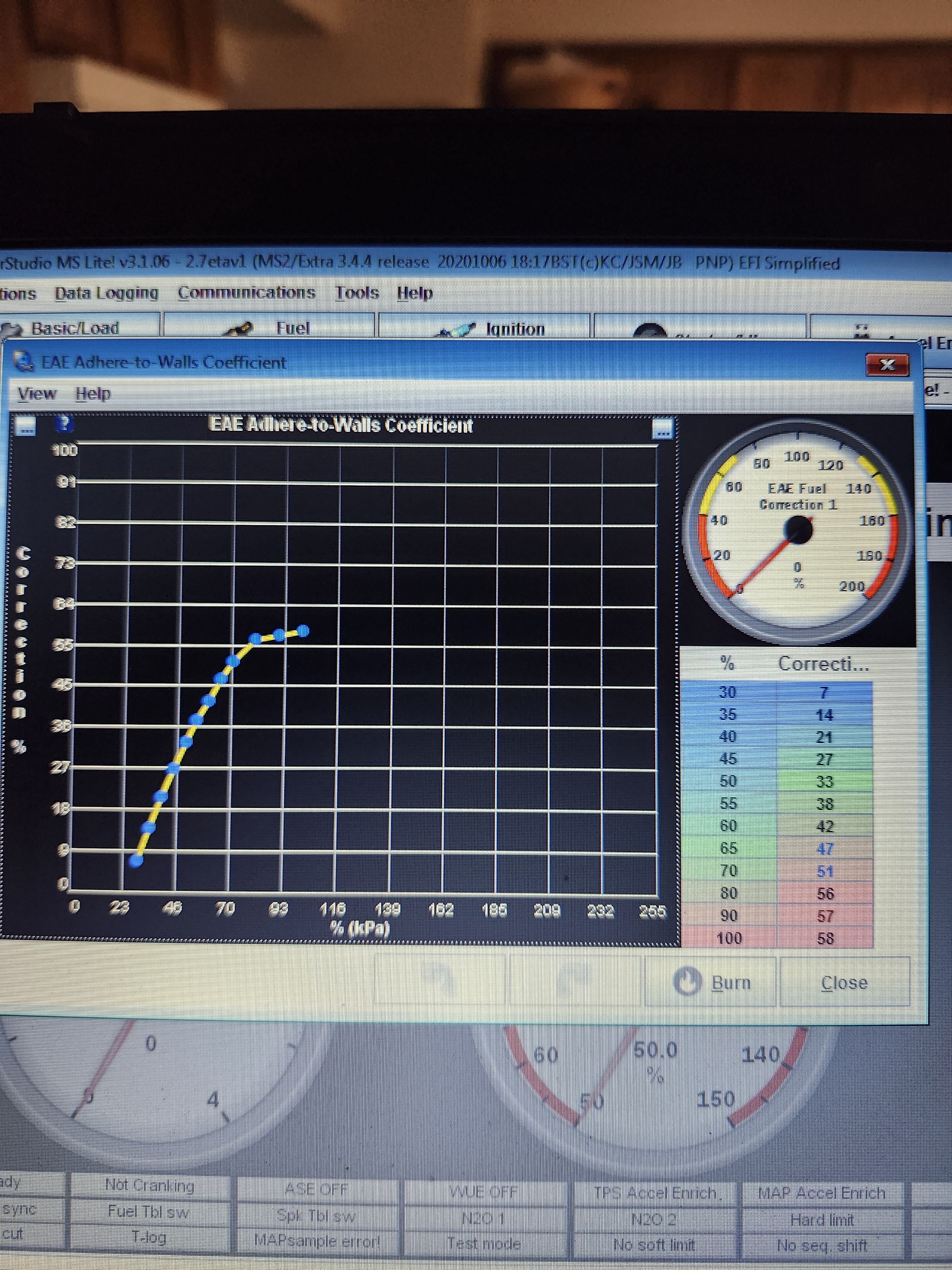
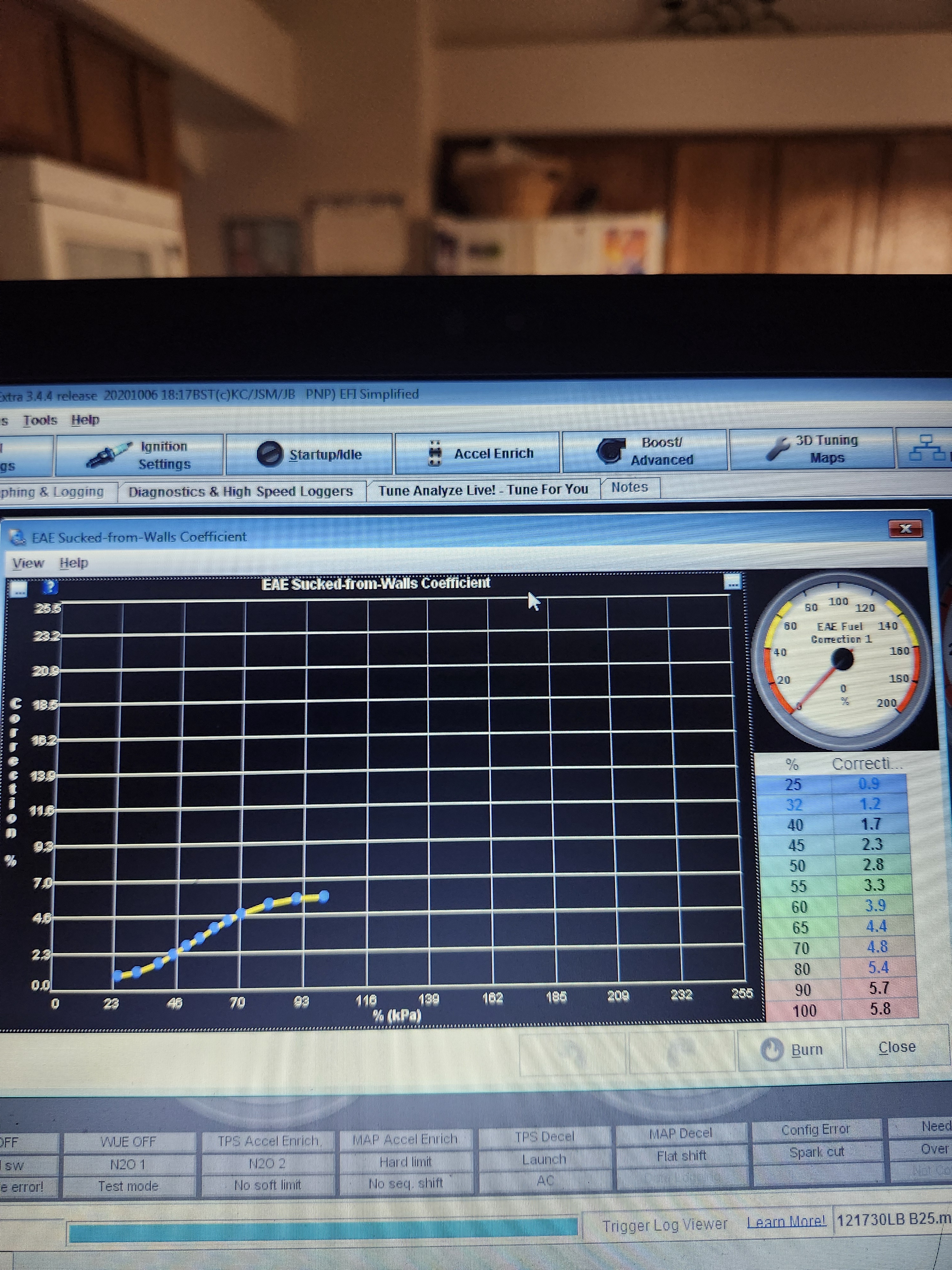
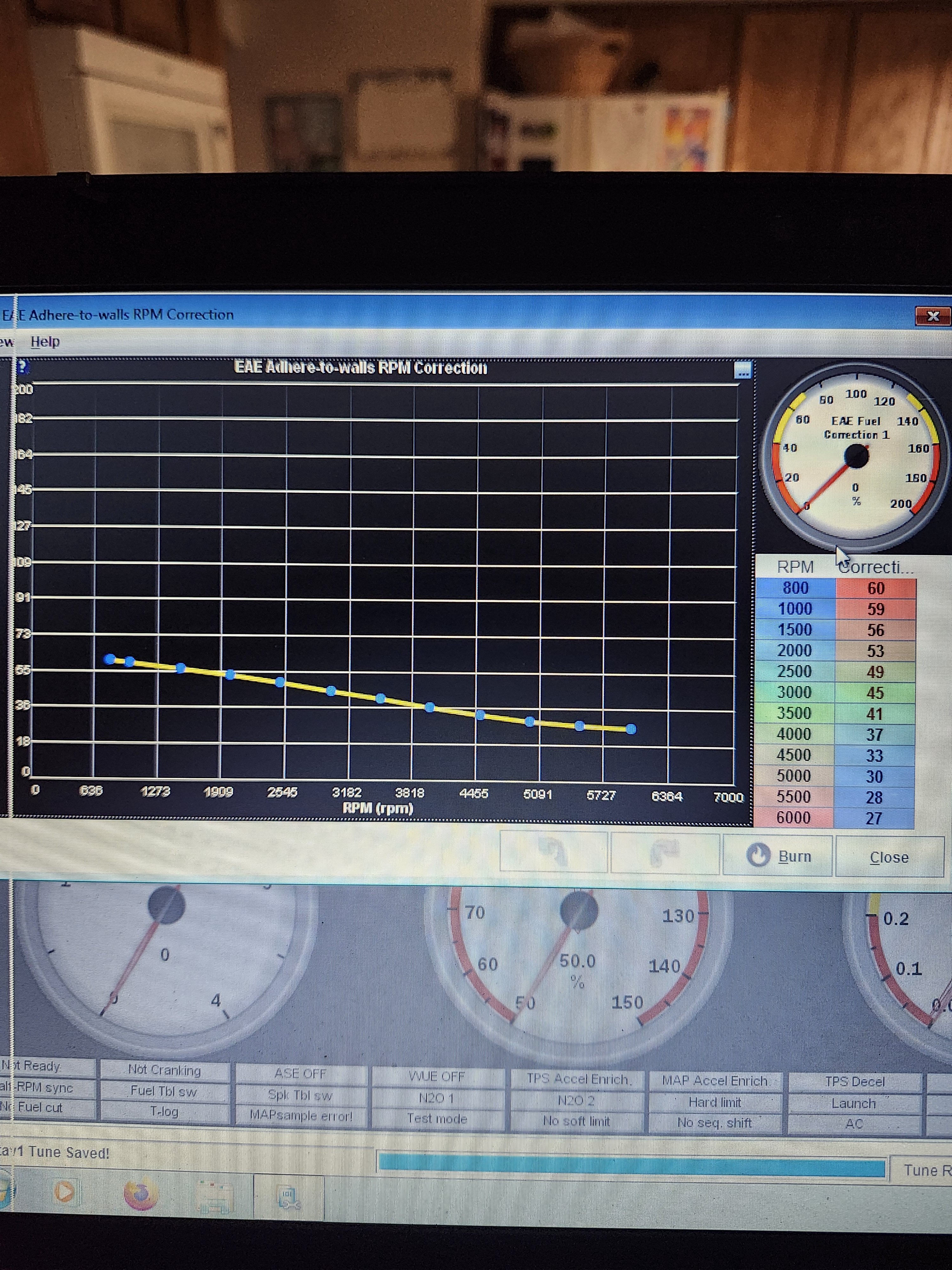
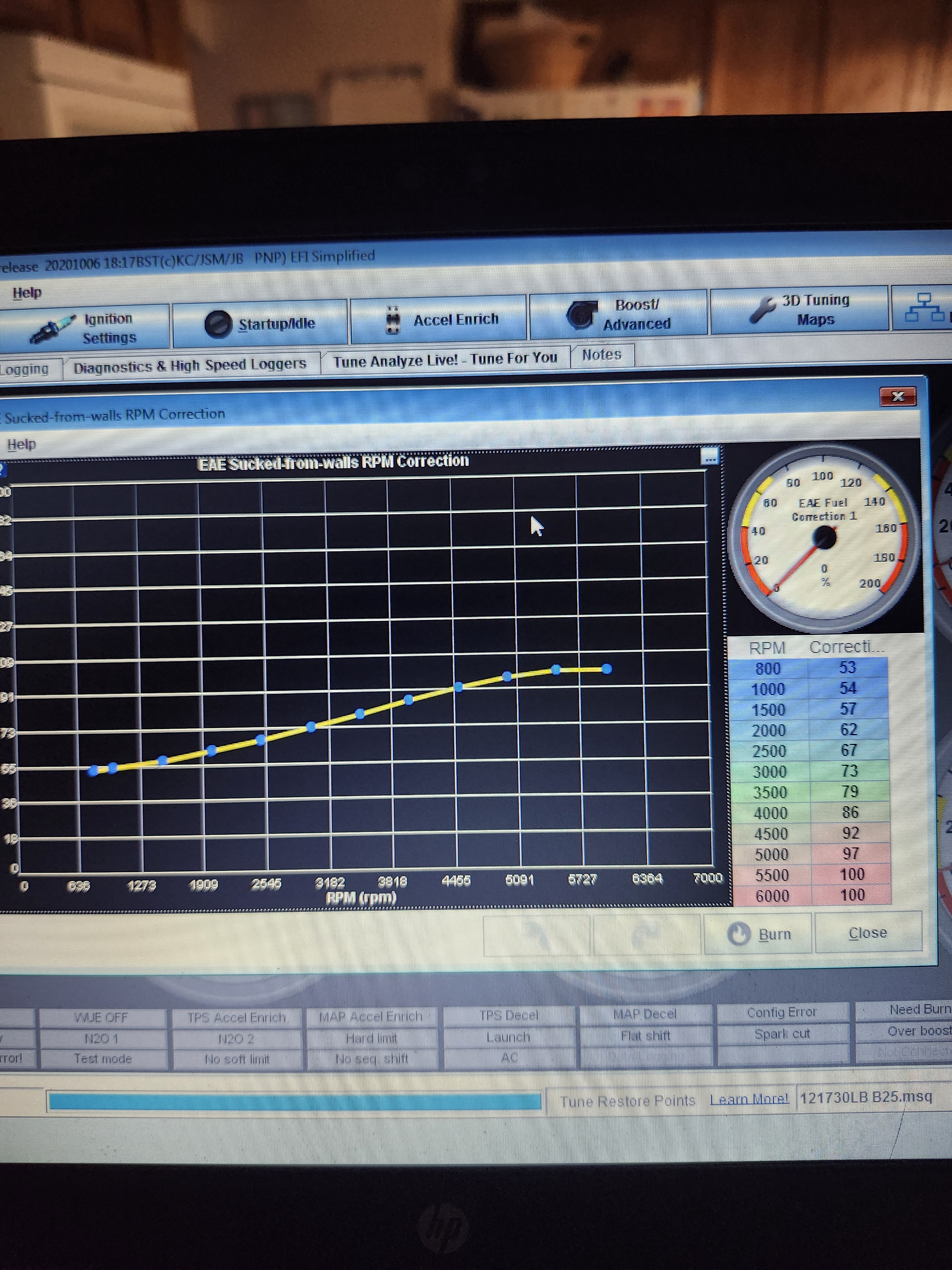
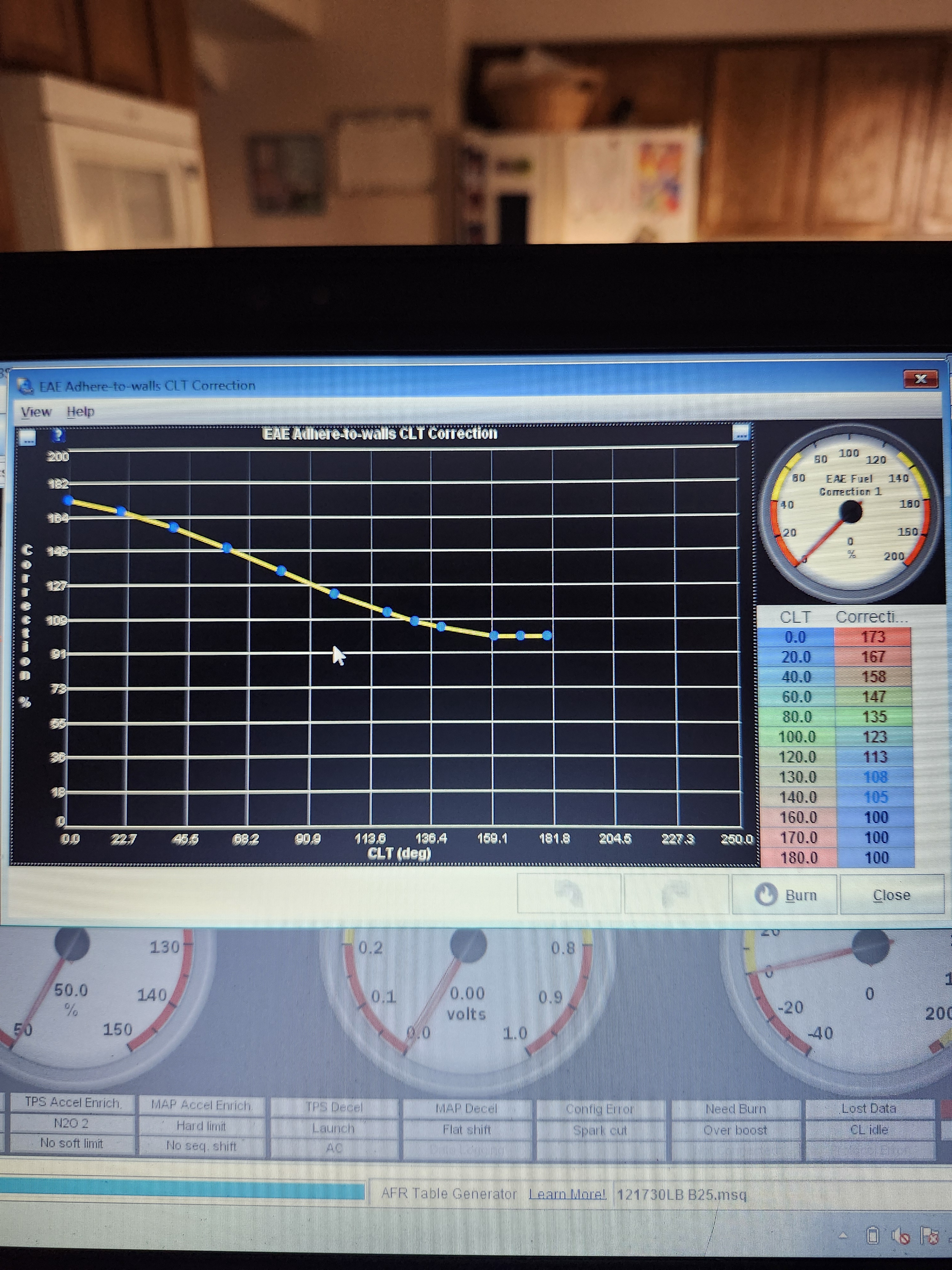
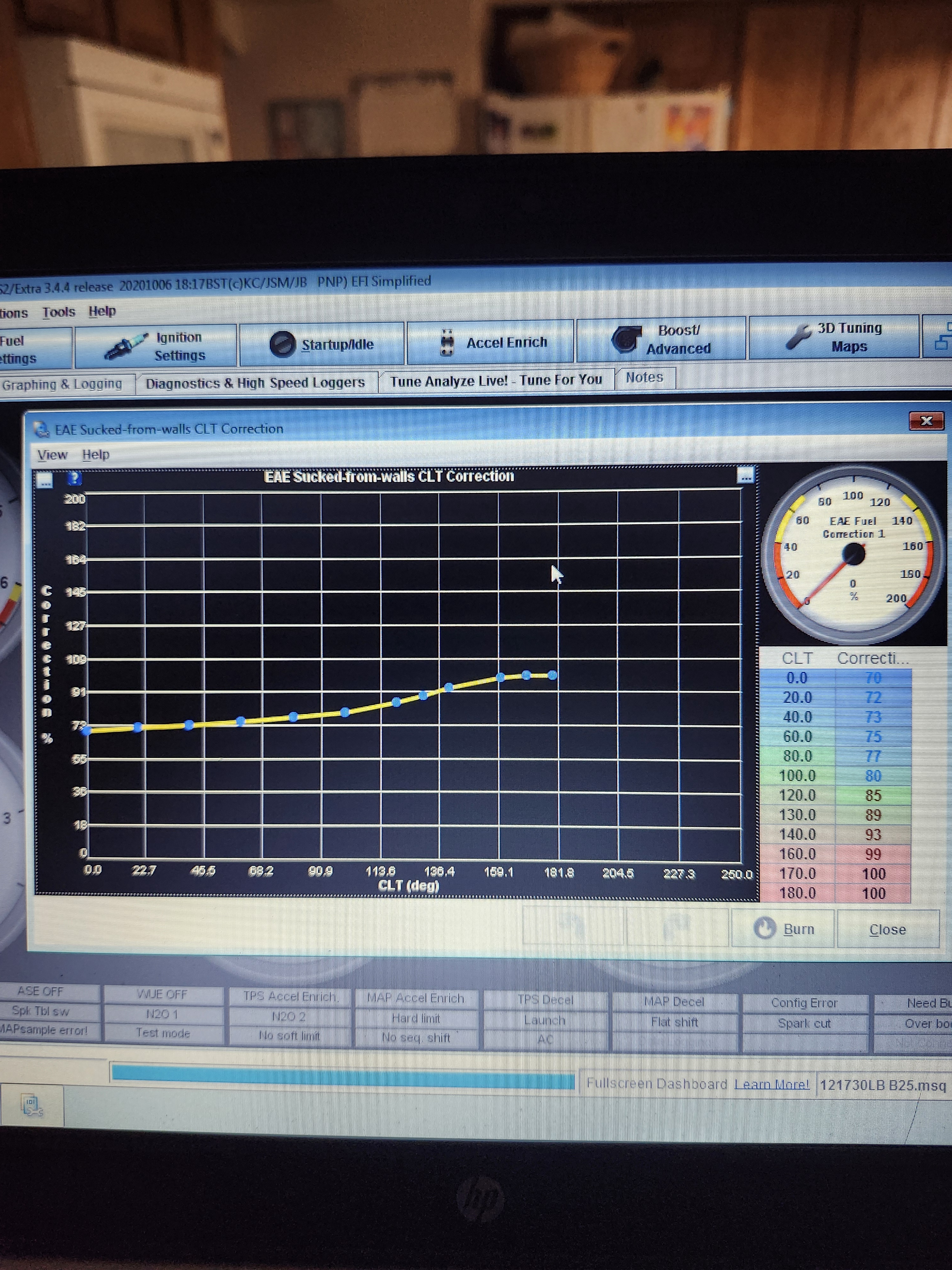
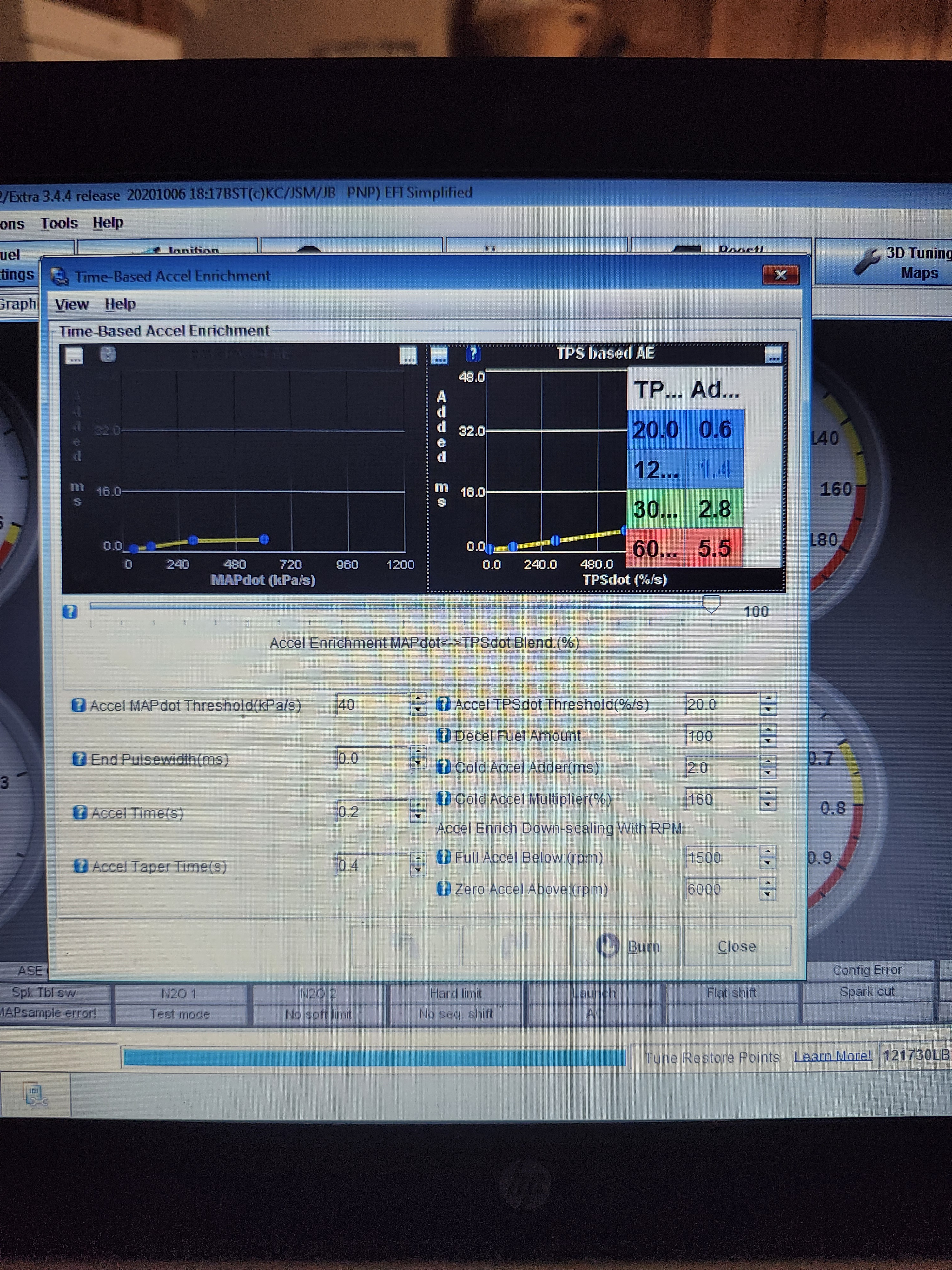
Better still during warm up. I also moved one of the low kpa bins on the SFW coefficient and increased the low end of that curve a little more. Overall it's working great without a whole lot of TPS AE.
I ordered a new turbo too. Got tired of trying not to buy a new turbo, this was the only solution. The price seems too good but it does appear to be a genuine Garrett. We'll see what it gets here. Seller appears to be legit and it is discontinued by Garrett, they might just be trying to get rid of them.
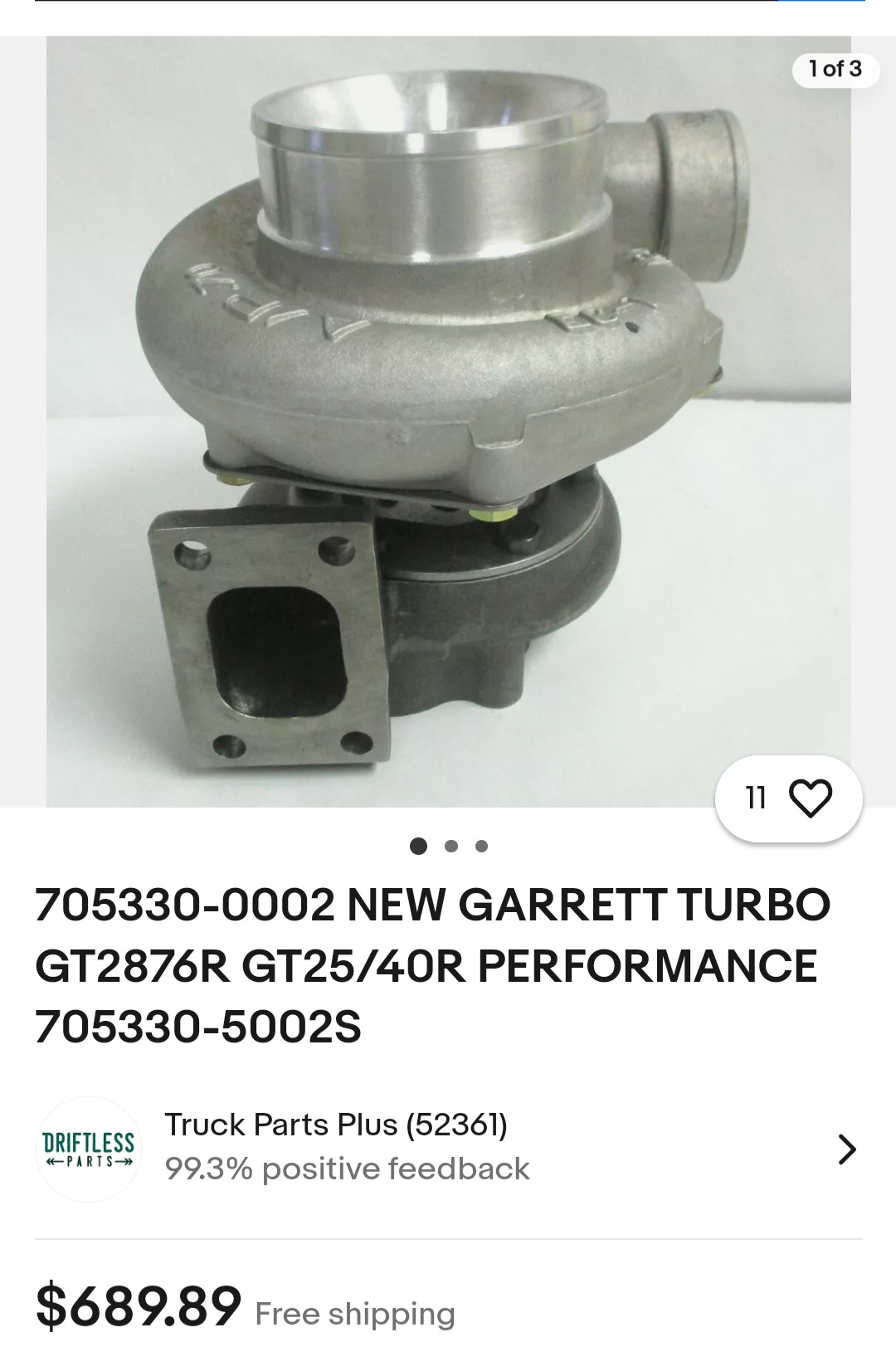
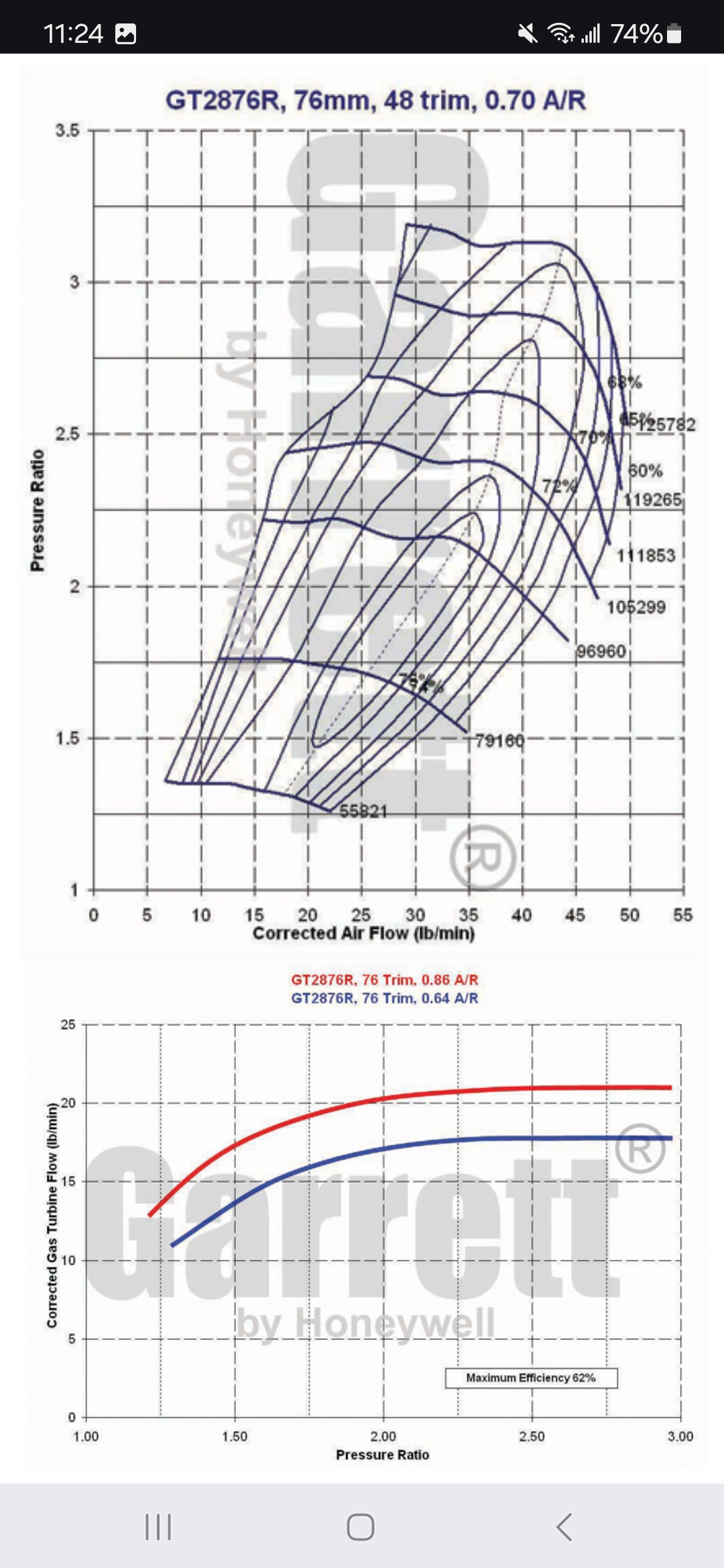
This is the .86 AR variety. I believe that was the same turbine wheel and housing I was running with the GT2871R back in 2007 or 2008. It worked very well, not too sleepy but it had enough capacity to avoid choking up on the top end.
I figure it's about time to put spark plugs in this thing. This set has a few miles on them. I'll be taking the turbo off for that and a valve clearance check and I didn't really want to put the little GT2560R back on. It's been great but its not efficient beyond about 11 psi. Since the stock clutch and fuel pump seem to be capable of at least 1 bar, I'll be running 1 bar. Looking at the compressor map, this thing is capable of making 450+ rear wheel. I would want to go for a larger and more efficient turbine if I was going to push it that hard, though running in the 300ish horsepower range will be no trouble at all.







Better still during warm up. I also moved one of the low kpa bins on the SFW coefficient and increased the low end of that curve a little more. Overall it's working great without a whole lot of TPS AE.
I ordered a new turbo too. Got tired of trying not to buy a new turbo, this was the only solution. The price seems too good but it does appear to be a genuine Garrett. We'll see what it gets here. Seller appears to be legit and it is discontinued by Garrett, they might just be trying to get rid of them.


This is the .86 AR variety. I believe that was the same turbine wheel and housing I was running with the GT2871R back in 2007 or 2008. It worked very well, not too sleepy but it had enough capacity to avoid choking up on the top end.
I figure it's about time to put spark plugs in this thing. This set has a few miles on them. I'll be taking the turbo off for that and a valve clearance check and I didn't really want to put the little GT2560R back on. It's been great but its not efficient beyond about 11 psi. Since the stock clutch and fuel pump seem to be capable of at least 1 bar, I'll be running 1 bar. Looking at the compressor map, this thing is capable of making 450+ rear wheel. I would want to go for a larger and more efficient turbine if I was going to push it that hard, though running in the 300ish horsepower range will be no trouble at all.
Re: Turbo ETA build
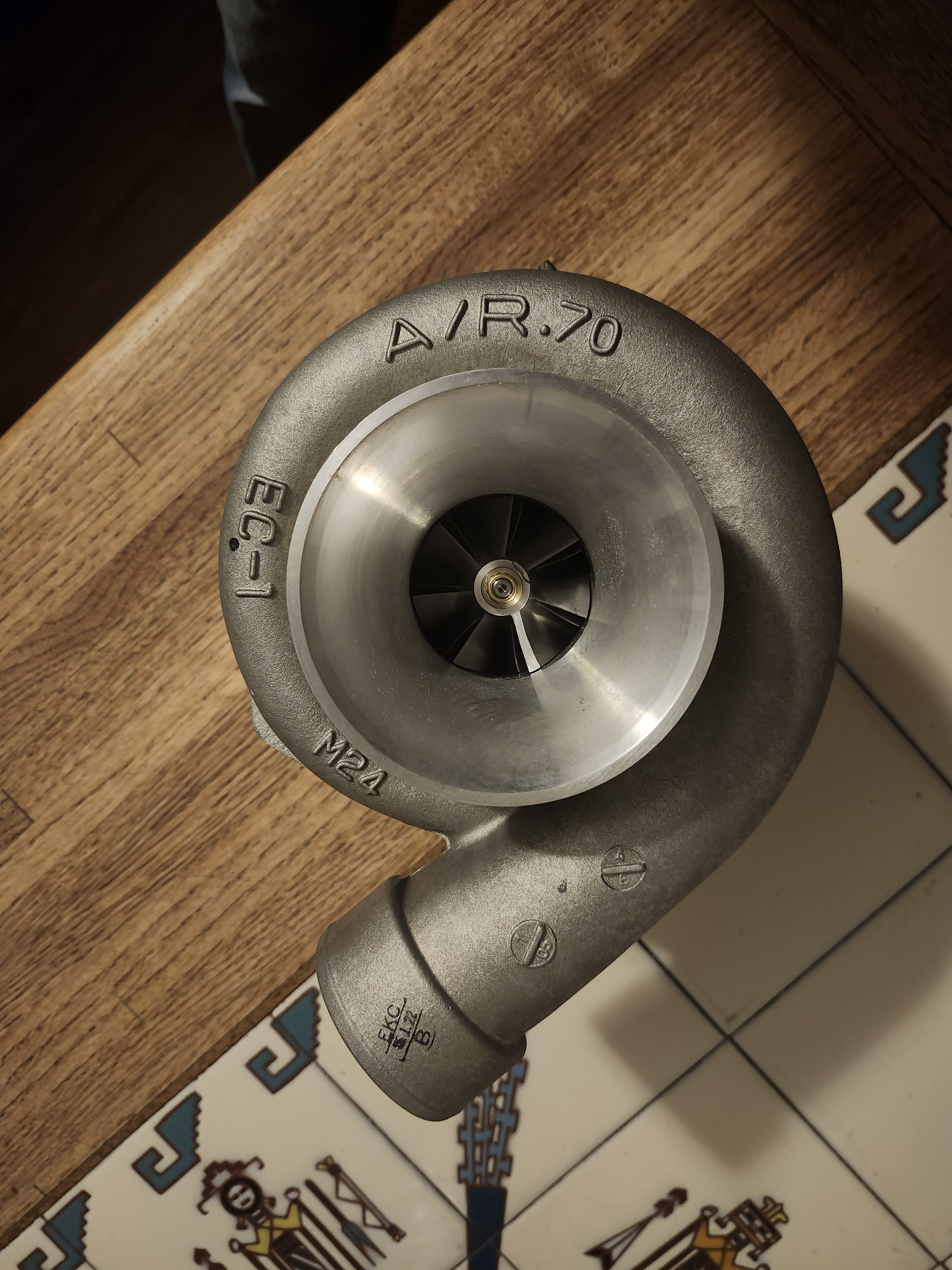
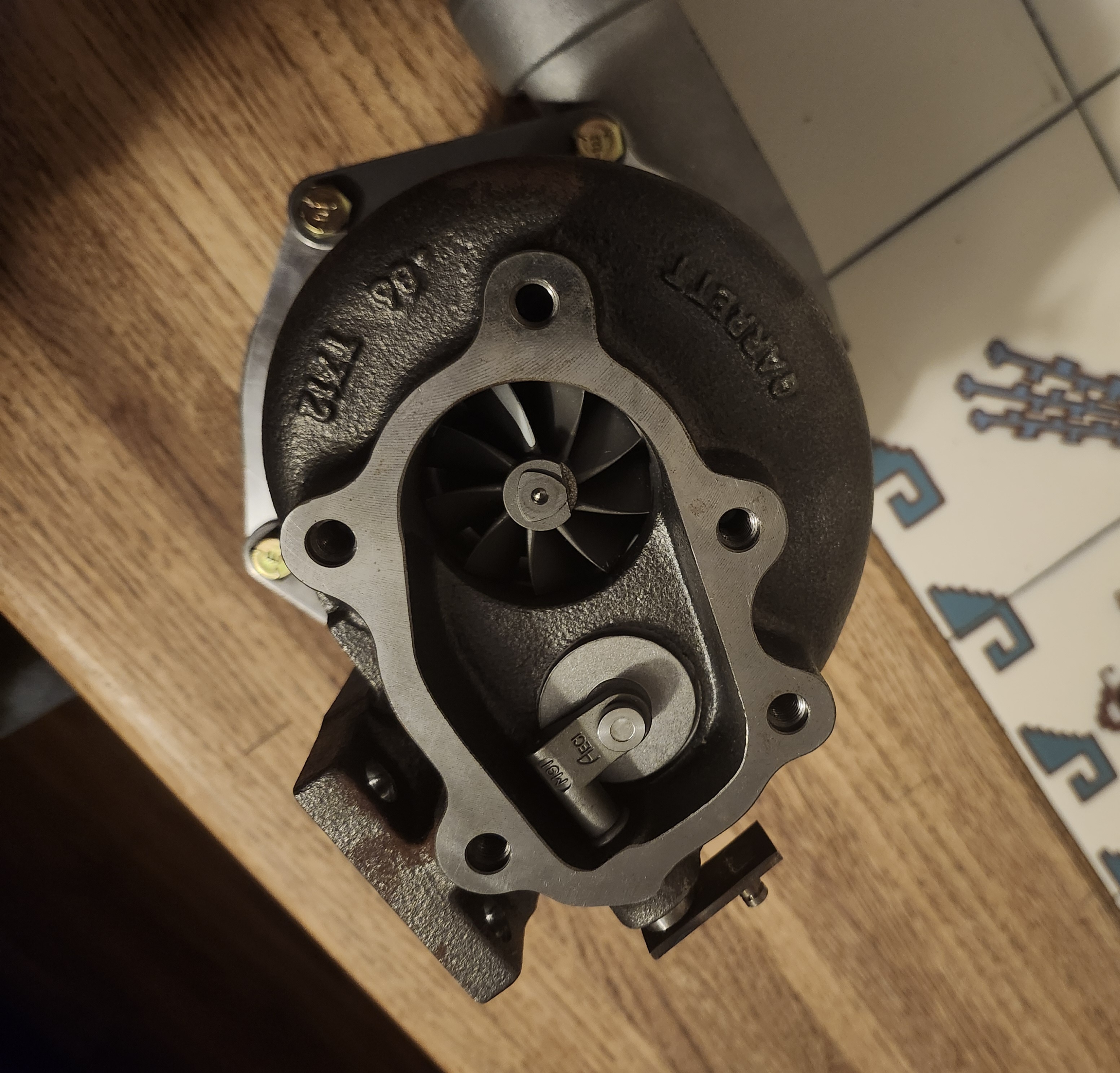
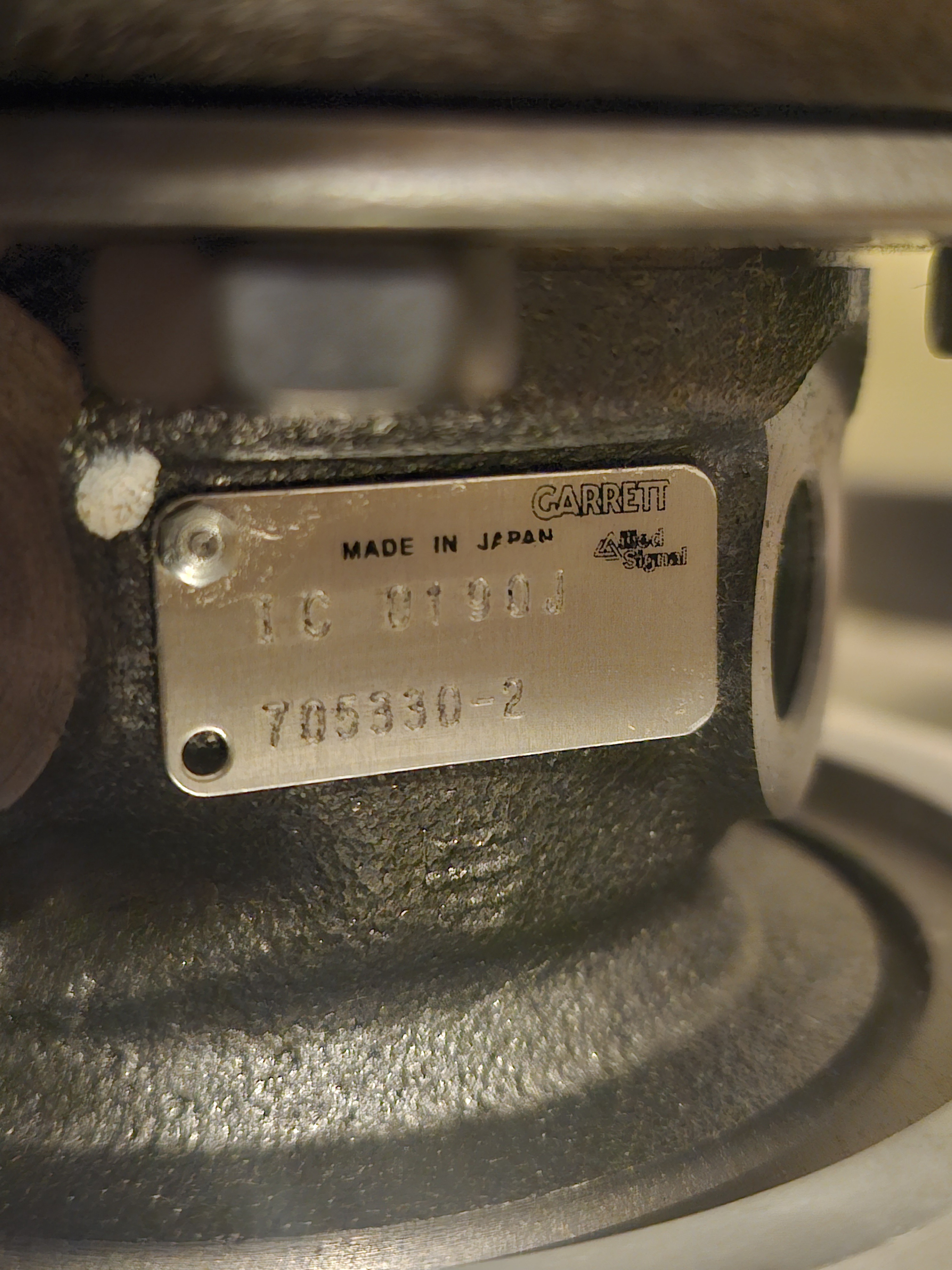
The suspiciously inexpensive GT2876R looks like the real deal. It did not come with a wastegate actuator bracket but I think I can sort that out. The compressor inlet is 4 inches in diameter so my intake plumbing will need work too. I hope the compressor housing clears the valve cover, it's definitely larger.
I used a coffee can here on one of the past builds. Some people didn't like that but I never had a problem with it.
Re: Turbo ETA build
Would you think of using a external gate? or is a internal better for what you are doing?

